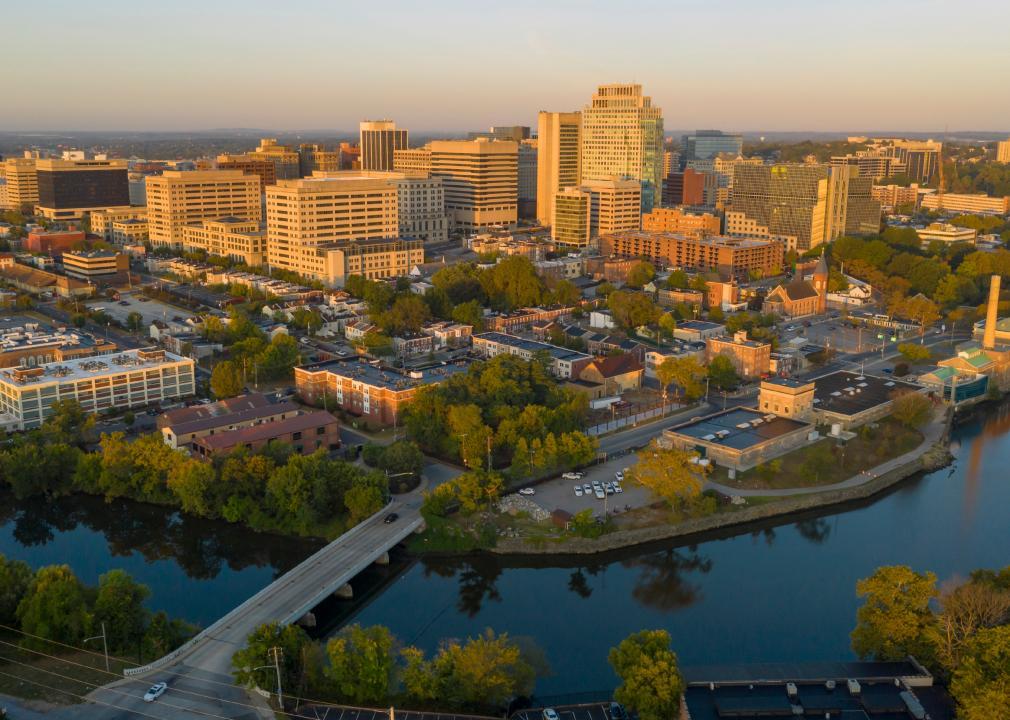Most and least educated states in America

michaeljung // Shutterstock
Most and least educated states in America
Group of graduates holding diplomas.
Each year, around 50 million young Americans attend public elementary and secondary schools, according to the National Center for Education Statistics, making the country’s educational system one of the farthest-reaching and most impactful government services. And while the debate over alternatives like charter schools rages on, one thing is undebatable: The future of the country lies in our youth, and our system’s ability to provide an education that will enable them to create productive and meaningful lives for themselves.
Because education is handled at the state level—from curricula and budgets to graduation requirements—a standard American education is somewhat hard to define. Formal academic education is one of the ways children and young adults obtain the information needed to seek individual enrichment. Moreover, the social interaction inherent in public educational settings helps young people develop the traits and skills needed to thrive in diverse social environments.
To what extent education influences a person’s ability to achieve a satisfactory level of well-being has been a constant matter of discussion among psychologists, sociologists, educators, and philosophers ever since the time of Socrates; however, there is greater consensus about how education affects living conditions. To wit, education has a causal relationship with income, housing, public policy, lifestyle, and health care. A study published by Virginia Commonwealth University’s Center of Society and Health found that people in the U.S. with less education face “serious health disadvantages.” According to the report, those whose formal education ended with high school “live with greater illnesses, have a shorter life expectancy, and tend to generate higher medical care costs.”
To help understand areas with the highest educational attainment, Stacker used data from the Census Bureau’s American Community Survey 5-Year Estimates, released in 2022, to determine areas with the highest educational attainment. This index evaluates each state’s population across seven educational tiers, ranging from individuals not educated past eighth grade to those with graduate or professional degrees. States are ranked by the percentage of the population with a graduate degree. Ties are broken by the percentage with a bachelor’s degree or higher.
How does your state stack up? Read on to discover which states are the most educated in the U.S.
![]()
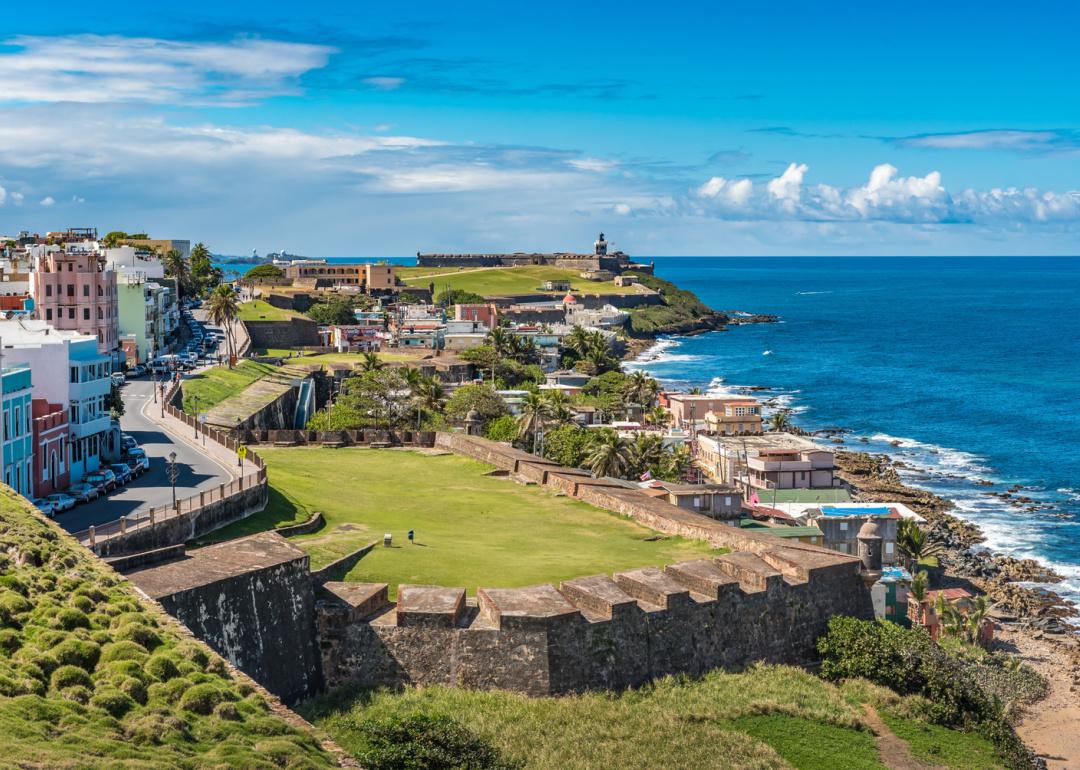
Terri Butler Photography // Shutterstock
#52. Puerto Rico
View of coast looking toward San Felipe del Morro.
Highest level of education completed:
– Less than 9th grade: 14.1%
– 9th to 12th grade, no diploma: 7.6%
– High school graduate (includes equivalency): 28.0%
– Some college, no degree: 11.9%
– Associate’s degree: 11.0%
– Bachelor’s degree: 19.6%
– Graduate or professional degree: 7.8%
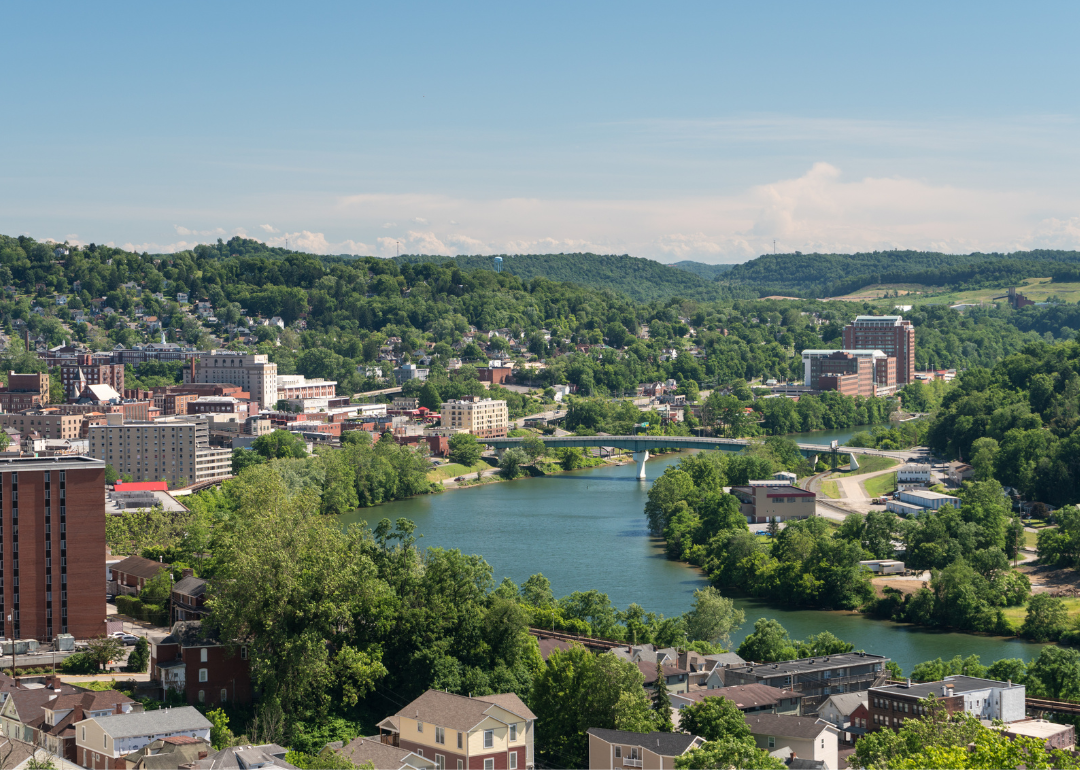
Canva
#51. West Virginia
Aerial view of Morgantown.
Highest level of education completed:
– Less than 9th grade: 3.8%
– 9th to 12th grade, no diploma: 8.1%
– High school graduate (includes equivalency): 40.1%
– Some college, no degree: 18.5%
– Associate’s degree: 7.7%
– Bachelor’s degree: 13.0%
– Graduate or professional degree: 8.8%
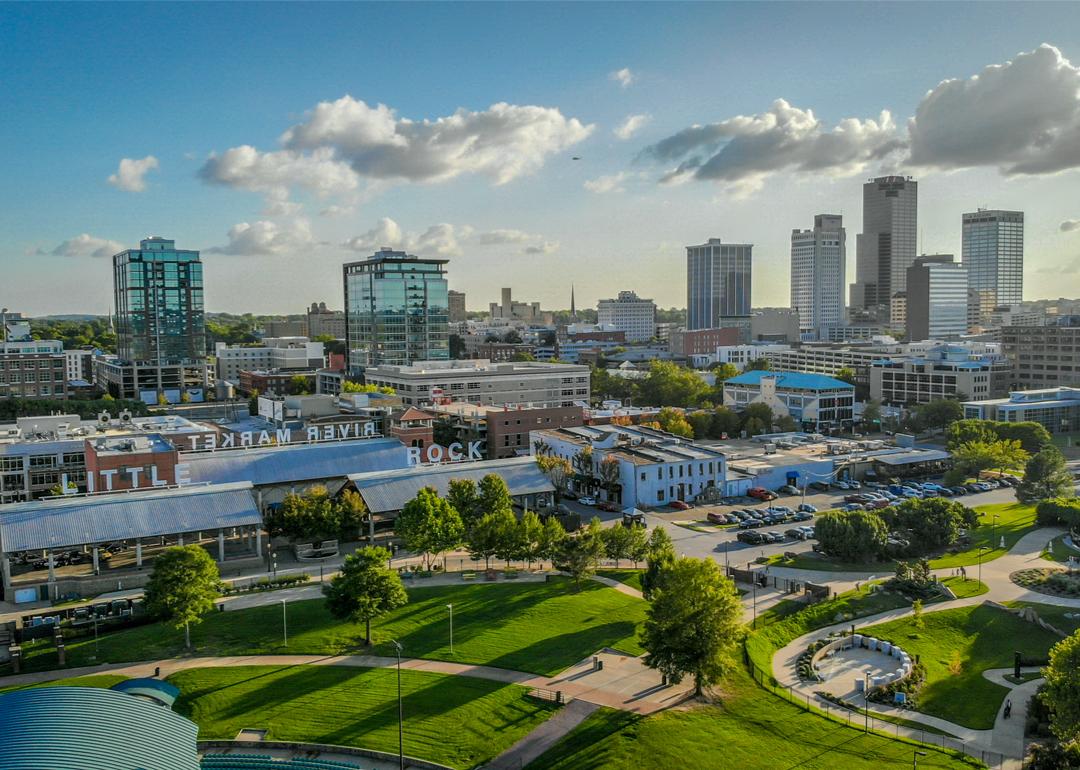
Eduardo Medrano // Shutterstock
#50. Arkansas
Afternoon Little Rock cityscape.
Highest level of education completed:
– Less than 9th grade: 4.6%
– 9th to 12th grade, no diploma: 7.7%
– High school graduate (includes equivalency): 34.1%
– Some college, no degree: 21.7%
– Associate’s degree: 7.7%
– Bachelor’s degree: 15.5%
– Graduate or professional degree: 8.8%
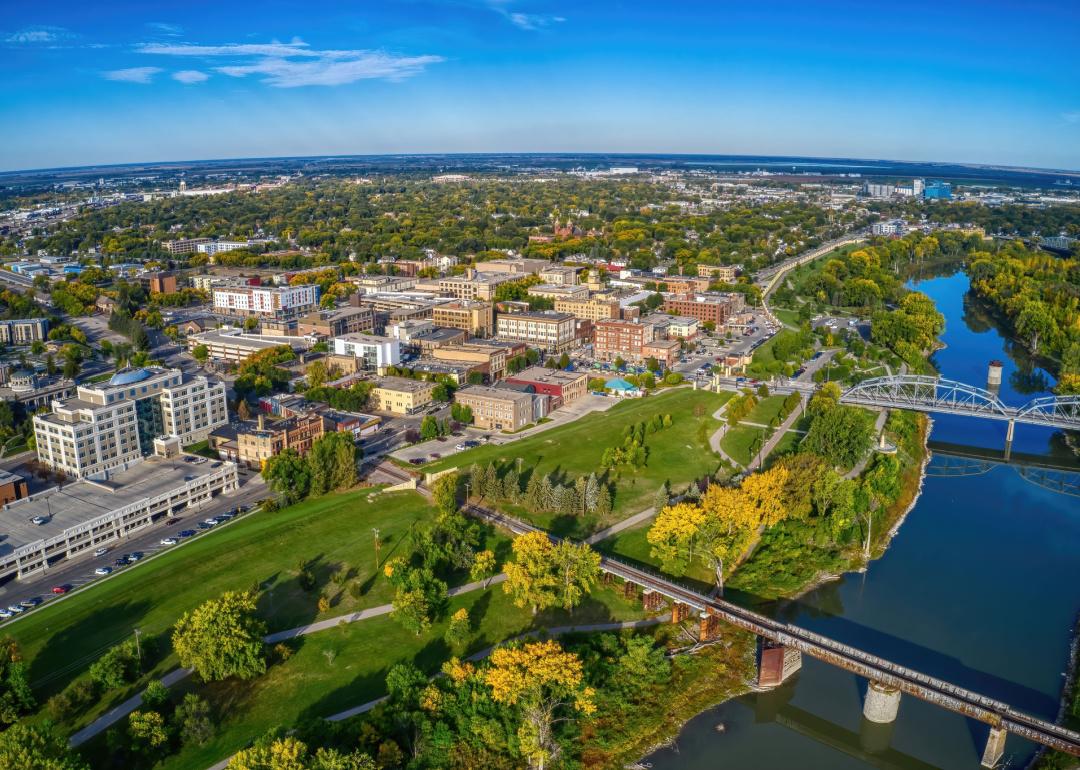
Jacob Boomsma // Shutterstock
#49. North Dakota
Aerial view of Grand Forks.
Highest level of education completed:
– Less than 9th grade: 2.6%
– 9th to 12th grade, no diploma: 4.1%
– High school graduate (includes equivalency): 26.1%
– Some college, no degree: 22.0%
– Associate’s degree: 14.1%
– Bachelor’s degree: 22.2%
– Graduate or professional degree: 8.9%
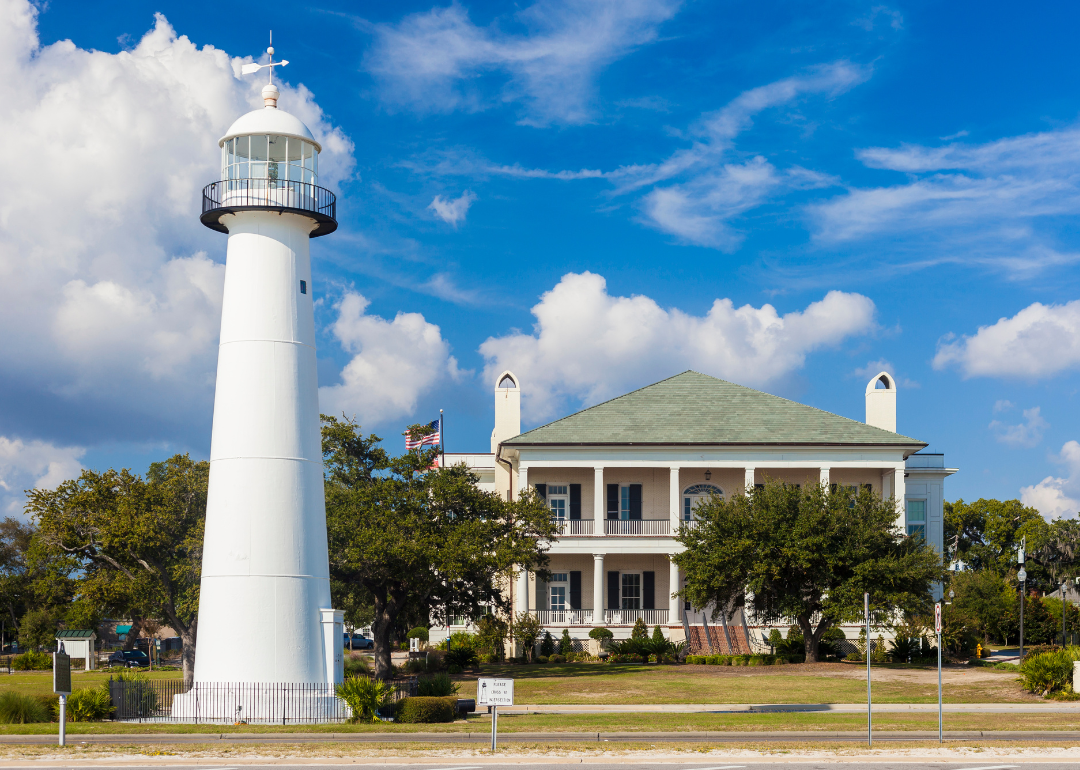
Canva
#48. Mississippi
Biloxi lighthouse.
Highest level of education completed:
– Less than 9th grade: 4.7%
– 9th to 12th grade, no diploma: 9.7%
– High school graduate (includes equivalency): 29.8%
– Some college, no degree: 22.1%
– Associate’s degree: 10.5%
– Bachelor’s degree: 14.2%
– Graduate or professional degree: 9.0%
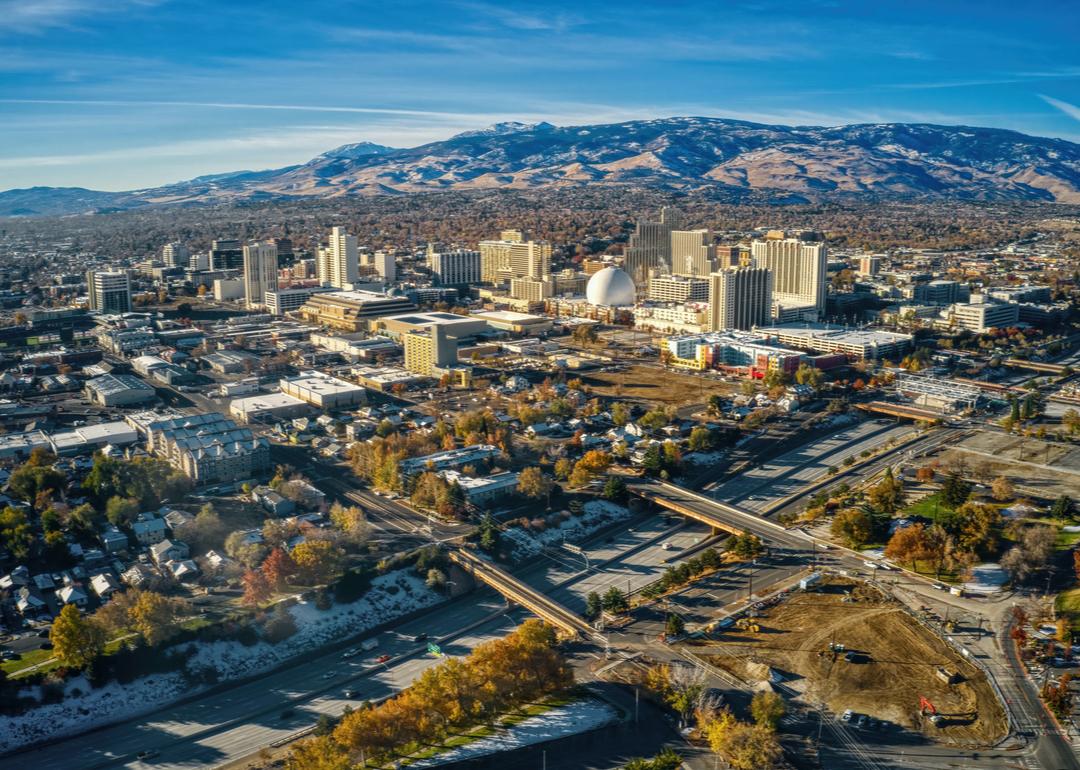
Jacob Boomsma // Shutterstock
#47. Nevada
Aerial view of Reno.
Highest level of education completed:
– Less than 9th grade: 5.3%
– 9th to 12th grade, no diploma: 7.6%
– High school graduate (includes equivalency): 27.8%
– Some college, no degree: 24.6%
– Associate’s degree: 8.6%
– Bachelor’s degree: 17.0%
– Graduate or professional degree: 9.1%
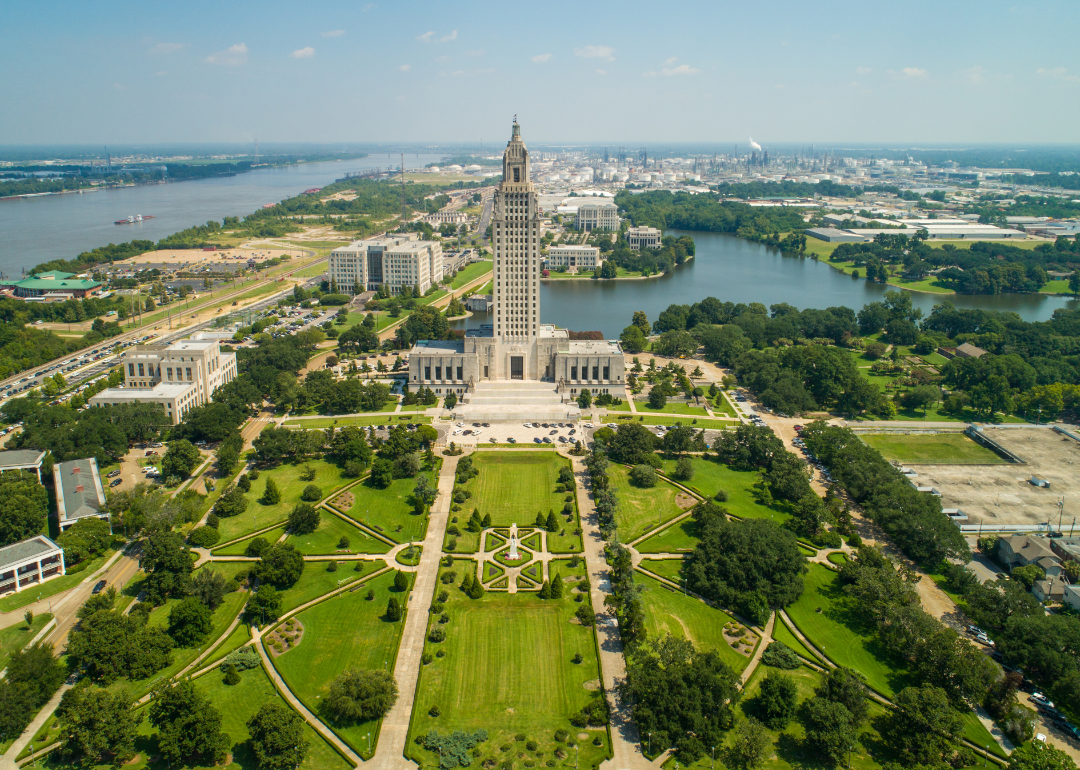
Canva
#46. Louisiana
Aerial photo Baton Rouge State Capitol Park.
Highest level of education completed:
– Less than 9th grade: 4.6%
– 9th to 12th grade, no diploma: 9.2%
– High school graduate (includes equivalency): 33.1%
– Some college, no degree: 20.9%
– Associate’s degree: 6.7%
– Bachelor’s degree: 16.3%
– Graduate or professional degree: 9.2%

Sean Pavone // Shutterstock
#45. Oklahoma
Oklahoma City downtown skyline in the late afternoon.
Highest level of education completed:
– Less than 9th grade: 3.8%
– 9th to 12th grade, no diploma: 7.4%
– High school graduate (includes equivalency): 30.8%
– Some college, no degree: 22.9%
– Associate’s degree: 8.2%
– Bachelor’s degree: 17.5%
– Graduate or professional degree: 9.3%

Steven Frame // Shutterstock
#44. South Dakota
People walking in Falls Park in Sioux Falls.
Highest level of education completed:
– Less than 9th grade: 2.7%
– 9th to 12th grade, no diploma: 4.8%
– High school graduate (includes equivalency): 30.1%
– Some college, no degree: 20.7%
– Associate’s degree: 11.8%
– Bachelor’s degree: 20.6%
– Graduate or professional degree: 9.4%
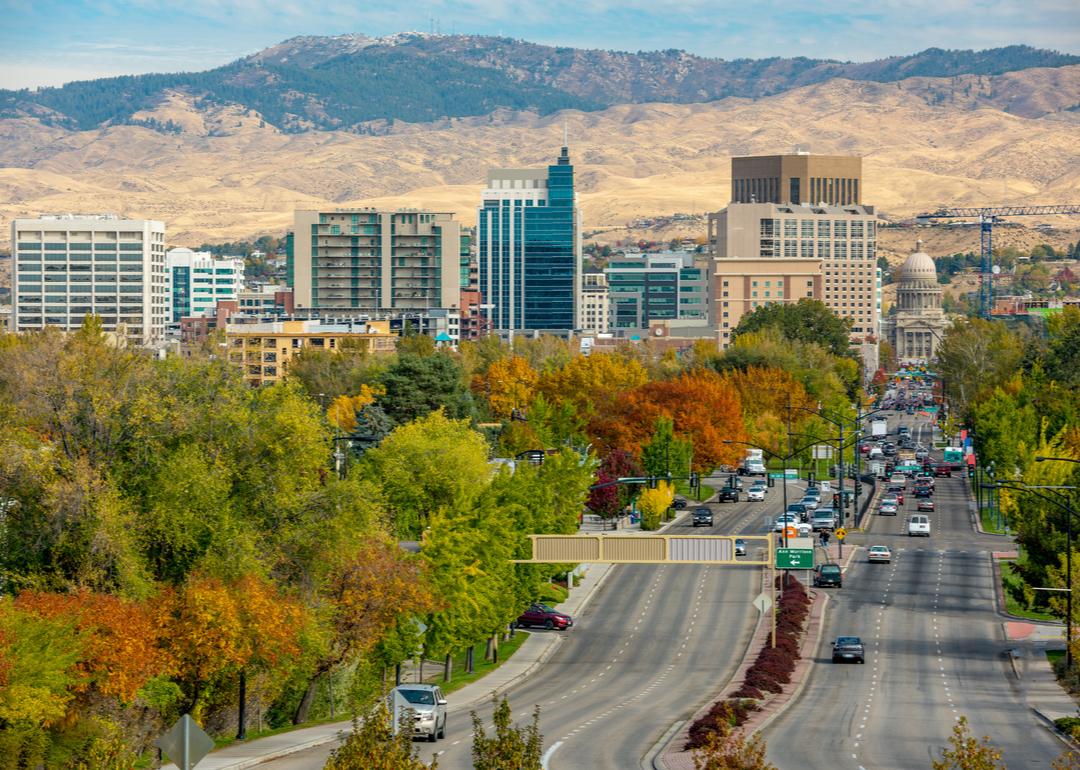
Charles Knowles // Shutterstock
#43. Idaho
Skyline of downtown Boise.
Highest level of education completed:
– Less than 9th grade: 3.2%
– 9th to 12th grade, no diploma: 5.6%
– High school graduate (includes equivalency): 26.5%
– Some college, no degree: 25.6%
– Associate’s degree: 9.9%
– Bachelor’s degree: 19.5%
– Graduate or professional degree: 9.6%

Grindstone Media Group // Shutterstock
#42. Iowa
Des Moines cityscape and sculpture park.
Highest level of education completed:
– Less than 9th grade: 2.8%
– 9th to 12th grade, no diploma: 4.4%
– High school graduate (includes equivalency): 30.6%
– Some college, no degree: 20.5%
– Associate’s degree: 12.0%
– Bachelor’s degree: 20.0%
– Graduate or professional degree: 9.7%
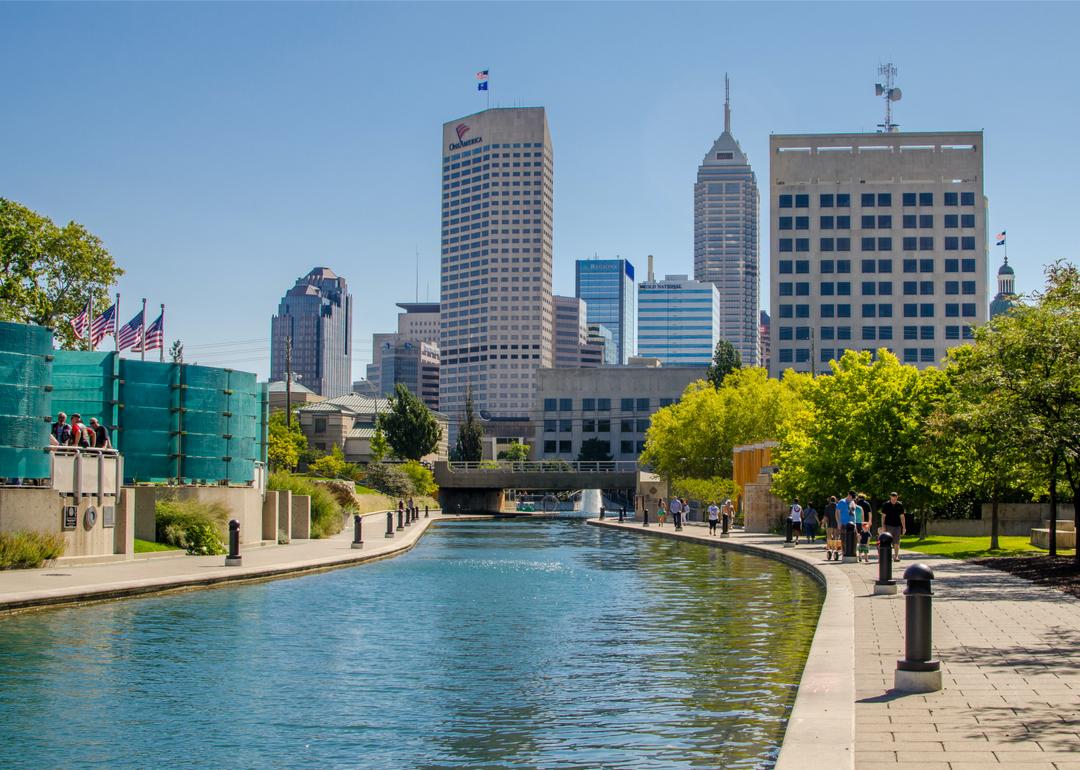
KYPhua // Shutterstock
#41. Indiana
Indianapolis skyline seen from canal walkway.
Highest level of education completed:
– Less than 9th grade: 3.5%
– 9th to 12th grade, no diploma: 6.7%
– High school graduate (includes equivalency): 33.0%
– Some college, no degree: 19.9%
– Associate’s degree: 9.0%
– Bachelor’s degree: 17.7%
– Graduate or professional degree: 10.1%
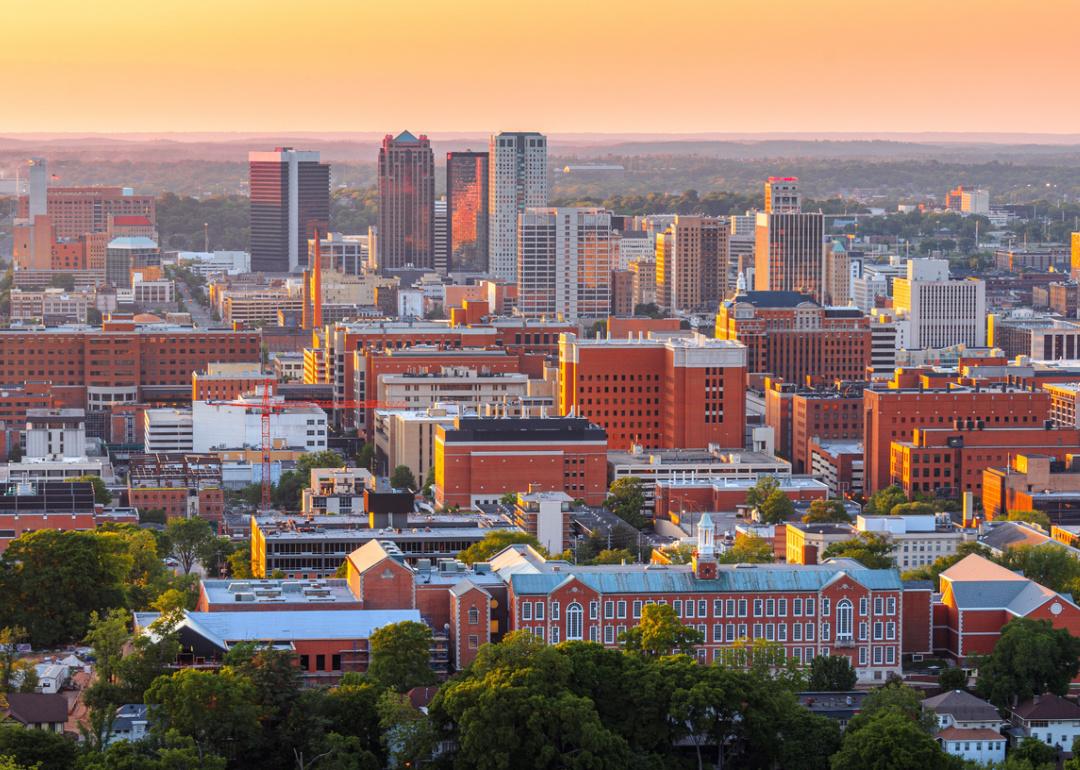
Sean Pavone // Shutterstock
#40. Alabama
Birmingham skyline at dusk.
Highest level of education completed:
– Less than 9th grade: 3.8%
– 9th to 12th grade, no diploma: 8.8%
– High school graduate (includes equivalency): 30.5%
– Some college, no degree: 21.3%
– Associate’s degree: 8.9%
– Bachelor’s degree: 16.5%
– Graduate or professional degree: 10.2%

f11photo // Shutterstock
#39. Kentucky
Louisville cityscape.
Highest level of education completed:
– Less than 9th grade: 4.8%
– 9th to 12th grade, no diploma: 7.6%
– High school graduate (includes equivalency): 32.8%
– Some college, no degree: 20.6%
– Associate’s degree: 8.6%
– Bachelor’s degree: 15.1%
– Graduate or professional degree: 10.6%
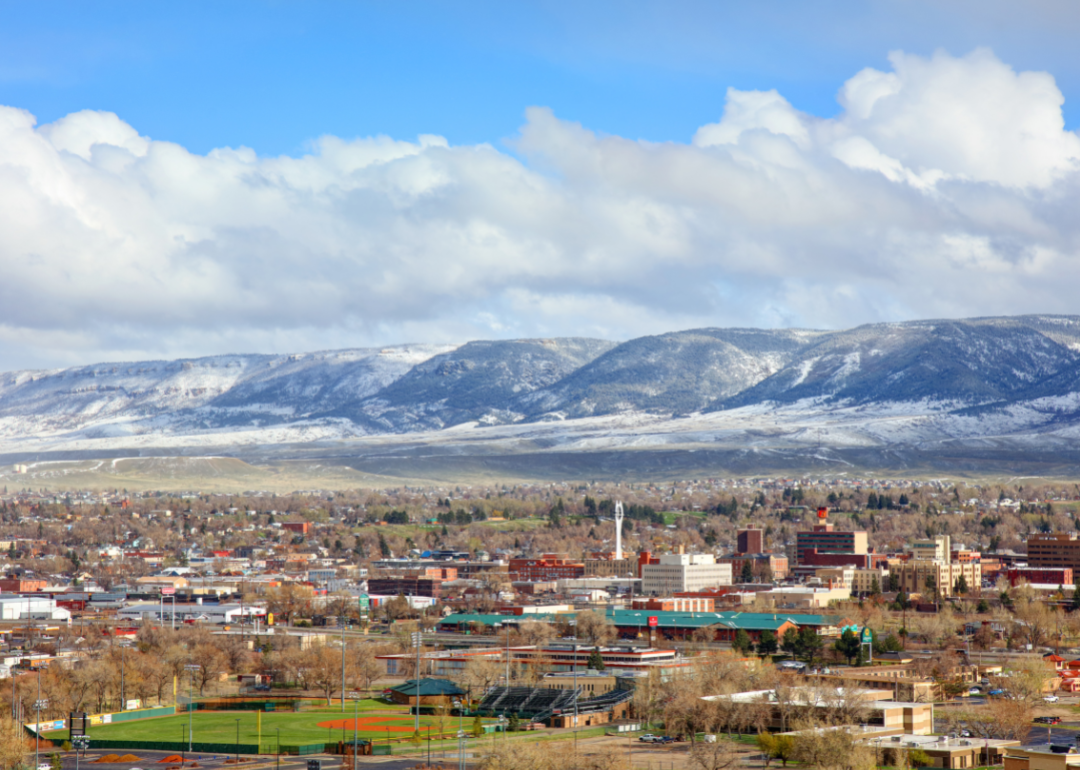
Canva
#38. Wyoming
Casper cityview with mountain range.
Highest level of education completed:
– Less than 9th grade: 1.8%
– 9th to 12th grade, no diploma: 4.5%
– High school graduate (includes equivalency): 28.4%
– Some college, no degree: 25.2%
– Associate’s degree: 11.6%
– Bachelor’s degree: 17.9%
– Graduate or professional degree: 10.6%
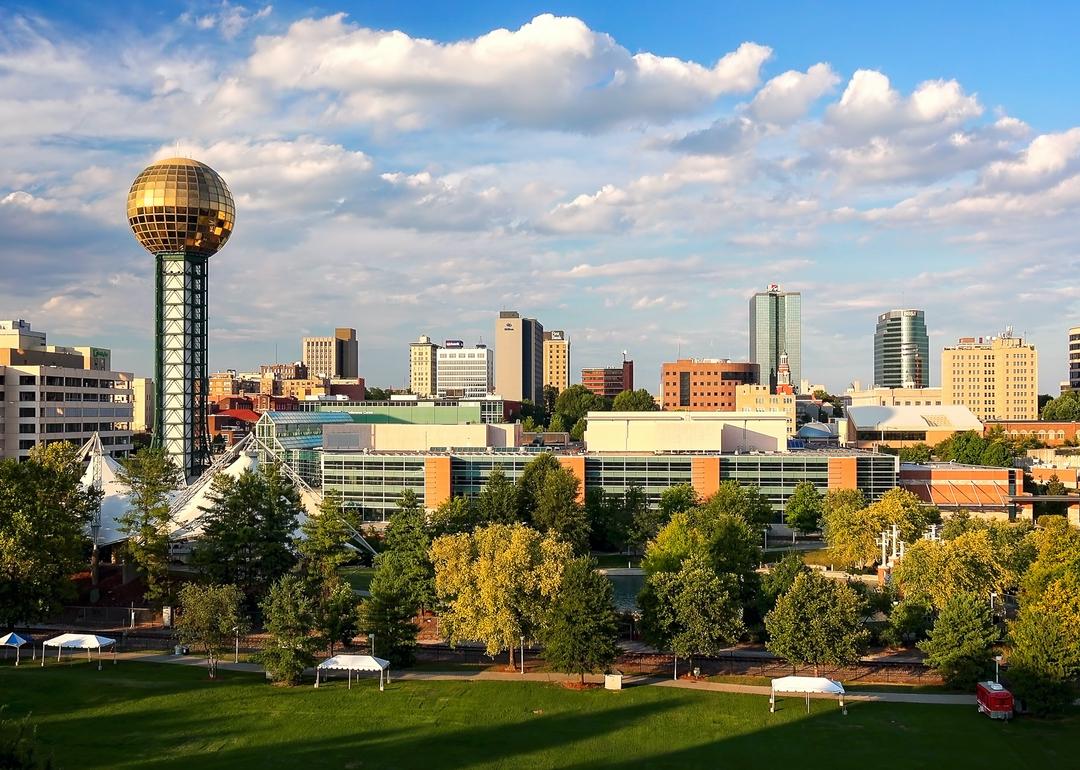
CrackerClips Stock Media // Shutterstock
#37. Tennessee
Knoxville skyline with Worlds Fair Park.
Highest level of education completed:
– Less than 9th grade: 4.0%
– 9th to 12th grade, no diploma: 7.2%
– High school graduate (includes equivalency): 31.6%
– Some college, no degree: 20.6%
– Associate’s degree: 7.6%
– Bachelor’s degree: 18.2%
– Graduate or professional degree: 10.8%
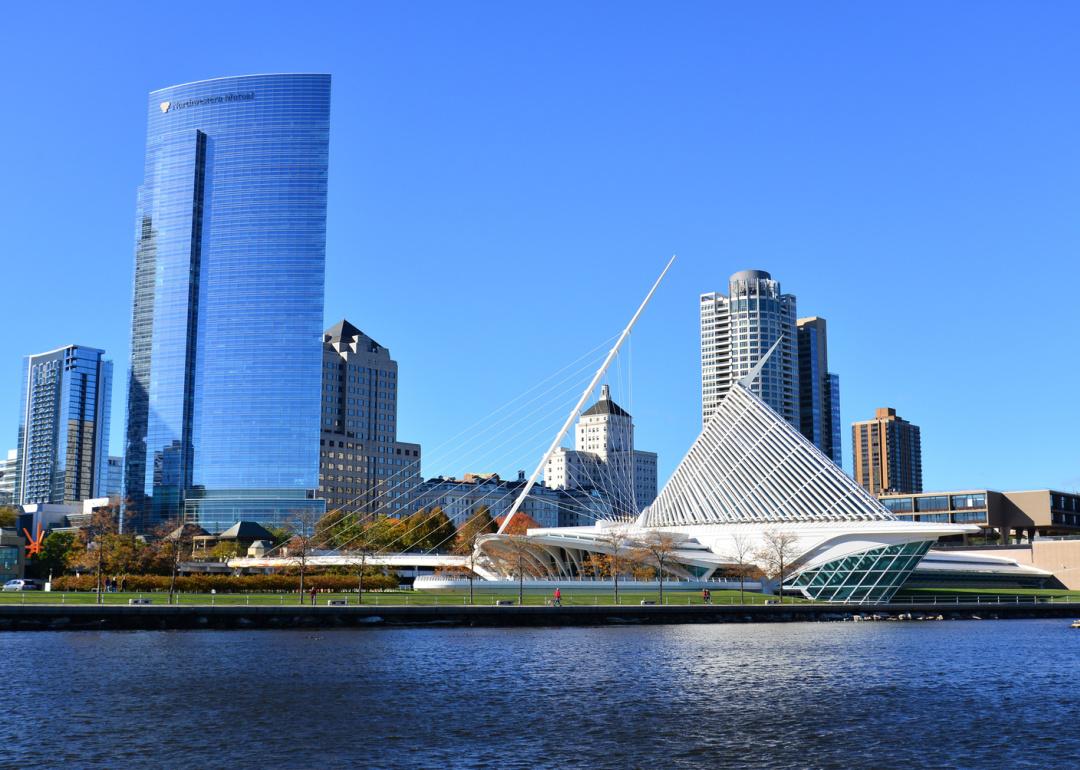
Tony Savino // Shutterstock
#36. Wisconsin
Milwaukee cityscape with Art Museum with the Northwestern Mutual building.
Highest level of education completed:
– Less than 9th grade: 2.4%
– 9th to 12th grade, no diploma: 4.7%
– High school graduate (includes equivalency): 30.0%
– Some college, no degree: 20.2%
– Associate’s degree: 11.2%
– Bachelor’s degree: 20.7%
– Graduate or professional degree: 10.8%
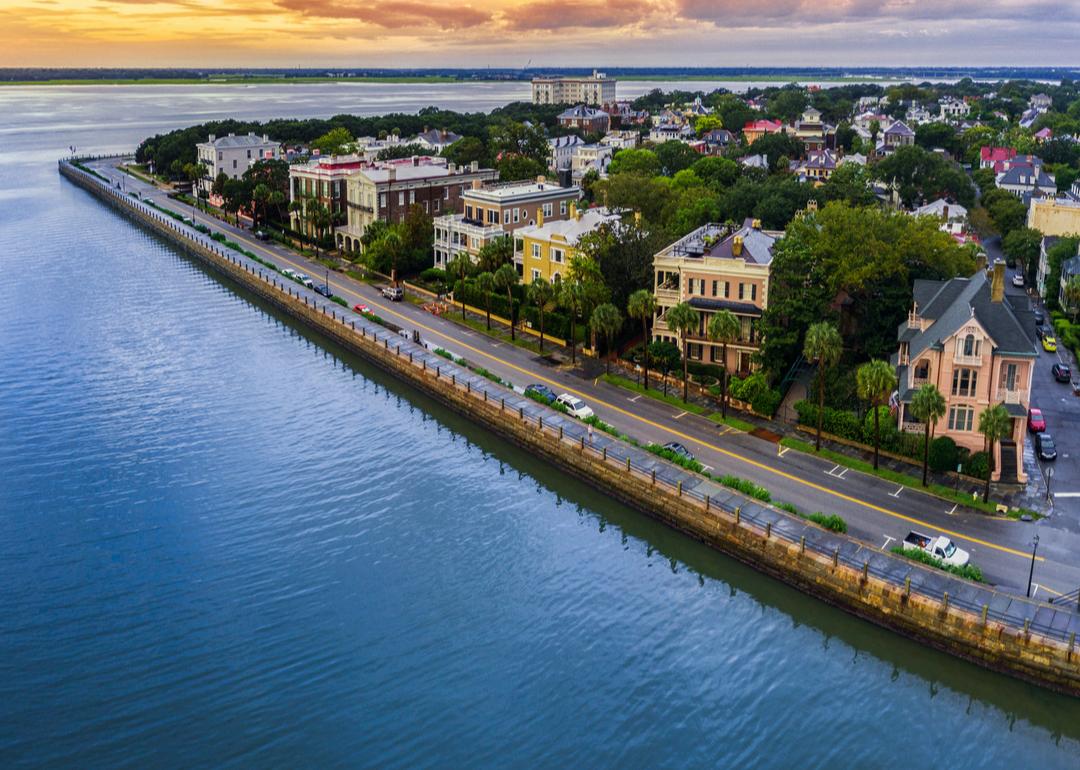
jdross75 // Shutterstock
#35. South Carolina
Aerial view Charleston waterfront.
Highest level of education completed:
– Less than 9th grade: 3.5%
– 9th to 12th grade, no diploma: 7.7%
– High school graduate (includes equivalency): 28.7%
– Some college, no degree: 20.2%
– Associate’s degree: 10.0%
– Bachelor’s degree: 18.6%
– Graduate or professional degree: 11.2%
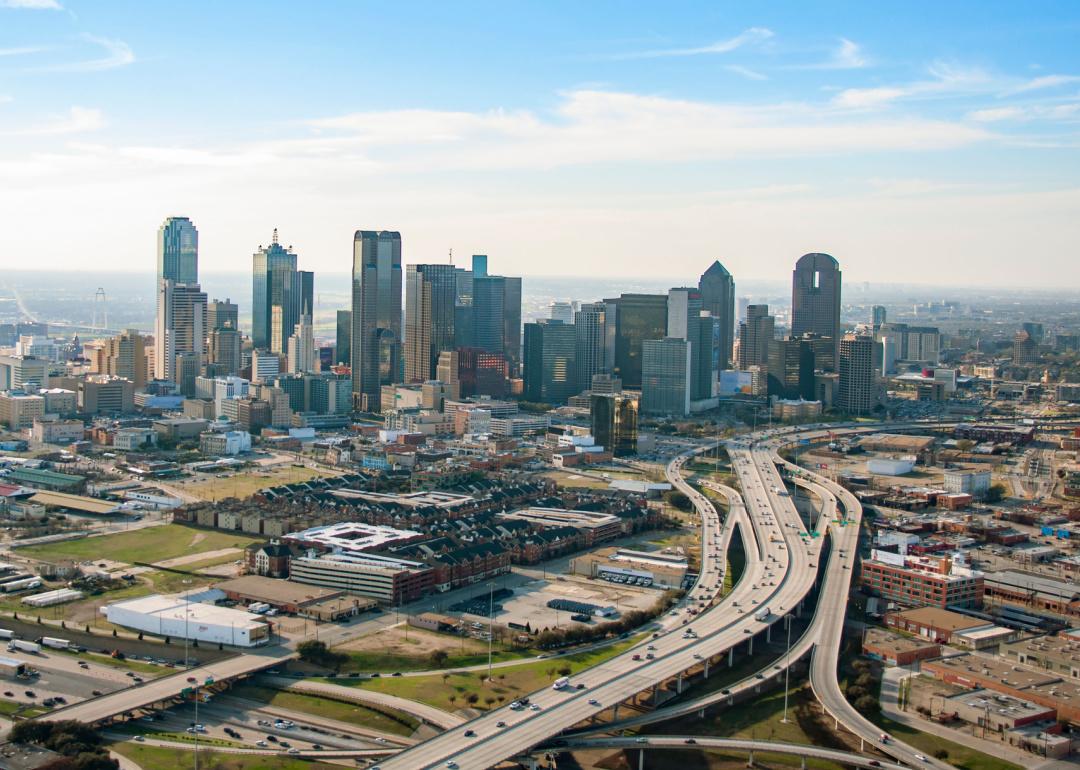
kintermedia // Shutterstock
#34. Texas
Aerial view of cityscape and highways.
Highest level of education completed:
– Less than 9th grade: 7.6%
– 9th to 12th grade, no diploma: 7.5%
– High school graduate (includes equivalency): 24.5%
– Some college, no degree: 21.2%
– Associate’s degree: 7.5%
– Bachelor’s degree: 20.4%
– Graduate or professional degree: 11.2%

photo.ua // Shutterstock
#33. Ohio
Cincinnati skyline and bridge.
Highest level of education completed:
– Less than 9th grade: 2.7%
– 9th to 12th grade, no diploma: 6.2%
– High school graduate (includes equivalency): 32.6%
– Some college, no degree: 20.0%
– Associate’s degree: 8.8%
– Bachelor’s degree: 18.4%
– Graduate or professional degree: 11.3%
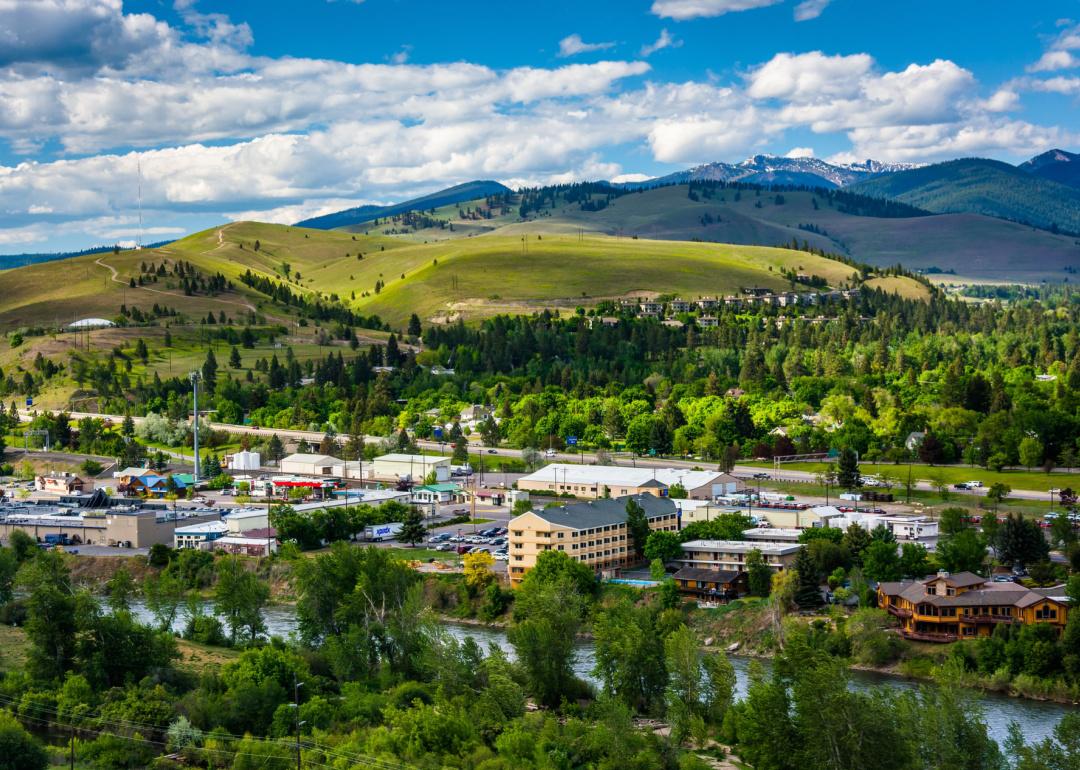
Jon Bilous // Shutterstock
#32. Montana
View of Missoula from Mount Sentinel.
Highest level of education completed:
– Less than 9th grade: 1.6%
– 9th to 12th grade, no diploma: 4.1%
– High school graduate (includes equivalency): 27.8%
– Some college, no degree: 23.4%
– Associate’s degree: 9.5%
– Bachelor’s degree: 22.3%
– Graduate or professional degree: 11.3%

Jacob Boomsma // Shutterstock
#31. Nebraska
Aerial view of downtown Omaha in autumn.
Highest level of education completed:
– Less than 9th grade: 3.8%
– 9th to 12th grade, no diploma: 4.5%
– High school graduate (includes equivalency): 25.6%
– Some college, no degree: 22.5%
– Associate’s degree: 10.7%
– Bachelor’s degree: 21.5%
– Graduate or professional degree: 11.4%

mffoto // Shutterstock
#30. Alaska
Aerial view of Haines city.
Highest level of education completed:
– Less than 9th grade: 2.3%
– 9th to 12th grade, no diploma: 4.5%
– High school graduate (includes equivalency): 28.5%
– Some college, no degree: 25.6%
– Associate’s degree: 8.6%
– Bachelor’s degree: 19.1%
– Graduate or professional degree: 11.5%
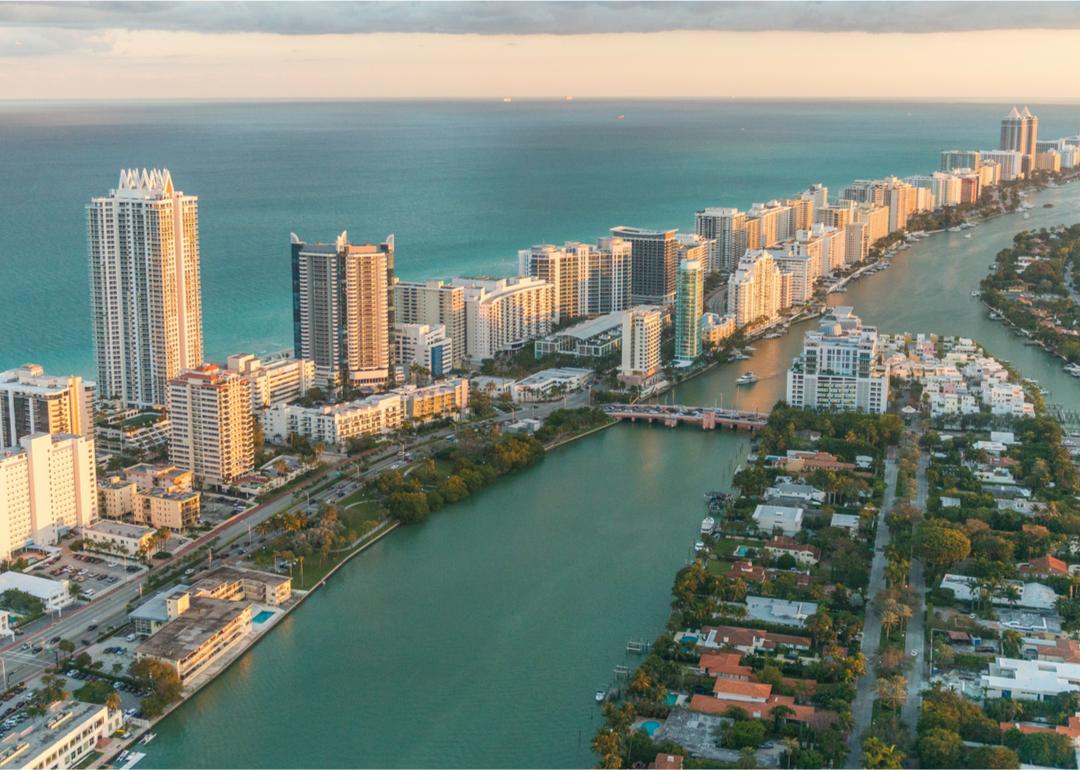
pisaphotography // Shutterstock
#29. Florida
Miami Beach aerial view.
Highest level of education completed:
– Less than 9th grade: 4.4%
– 9th to 12th grade, no diploma: 6.6%
– High school graduate (includes equivalency): 27.9%
– Some college, no degree: 19.5%
– Associate’s degree: 10.1%
– Bachelor’s degree: 19.8%
– Graduate or professional degree: 11.7%
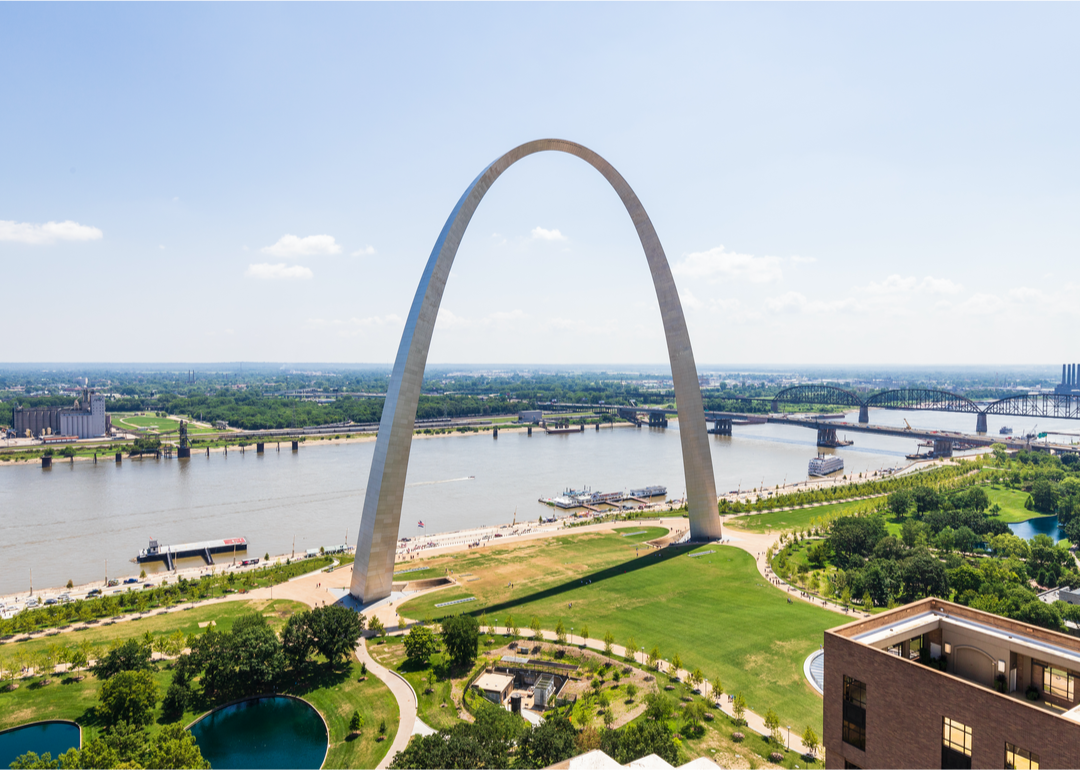
Joe Hendrickson // Shutterstock
#28. Missouri
Aerial view of The Gateway Arch and riverfront in downtown St. Louis.
Highest level of education completed:
– Less than 9th grade: 2.8%
– 9th to 12th grade, no diploma: 6.3%
– High school graduate (includes equivalency): 30.5%
– Some college, no degree: 21.6%
– Associate’s degree: 8.2%
– Bachelor’s degree: 18.9%
– Graduate or professional degree: 11.8%
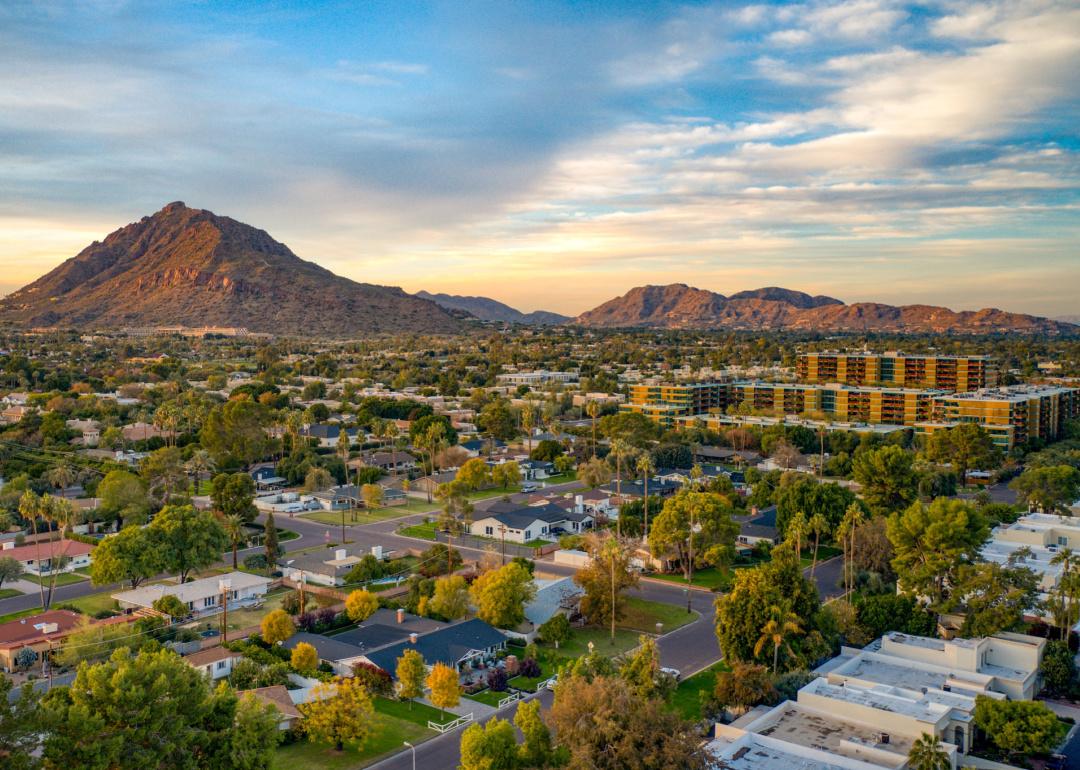
antsdrone // Shutterstock
#27. Arizona
Urban sunset over downtown Scottsdale.
Highest level of education completed:
– Less than 9th grade: 4.9%
– 9th to 12th grade, no diploma: 6.8%
– High school graduate (includes equivalency): 23.5%
– Some college, no degree: 24.6%
– Associate’s degree: 9.0%
– Bachelor’s degree: 19.3%
– Graduate or professional degree: 11.9%
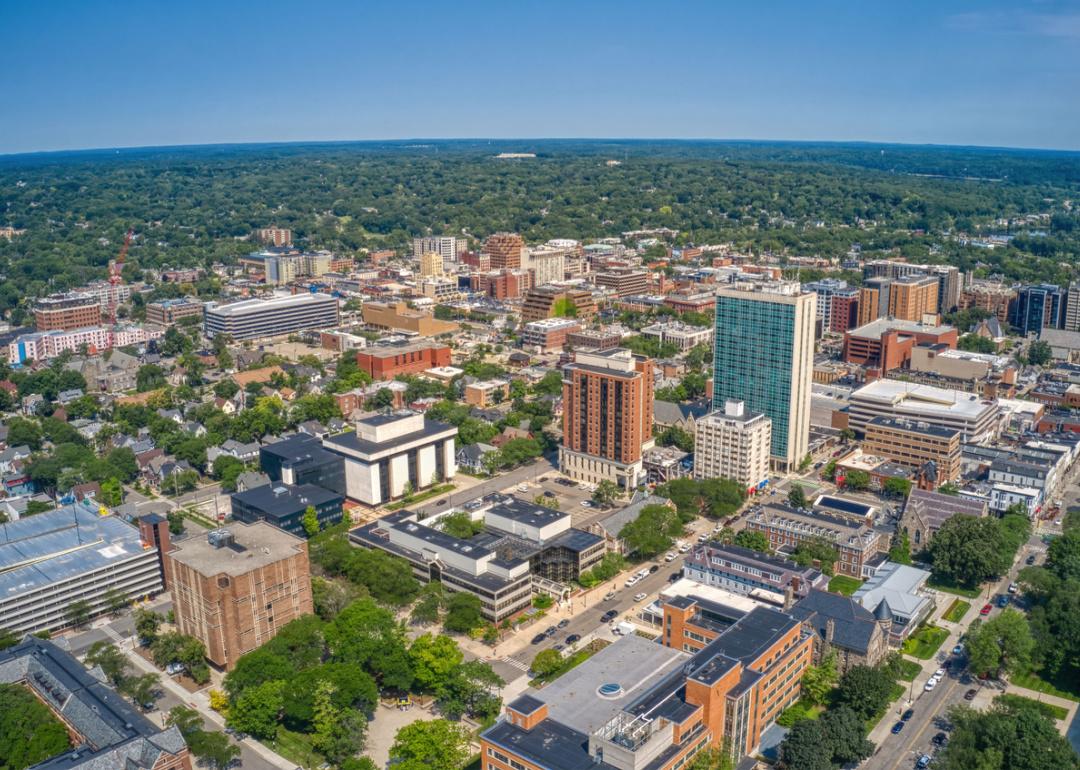
Jacob Boomsma // Shutterstock
#26. Michigan
Aerial view of downtown Ann Arbor in summer.
Highest level of education completed:
– Less than 9th grade: 2.6%
– 9th to 12th grade, no diploma: 5.8%
– High school graduate (includes equivalency): 28.5%
– Some college, no degree: 22.8%
– Associate’s degree: 9.7%
– Bachelor’s degree: 18.6%
– Graduate or professional degree: 12.0%
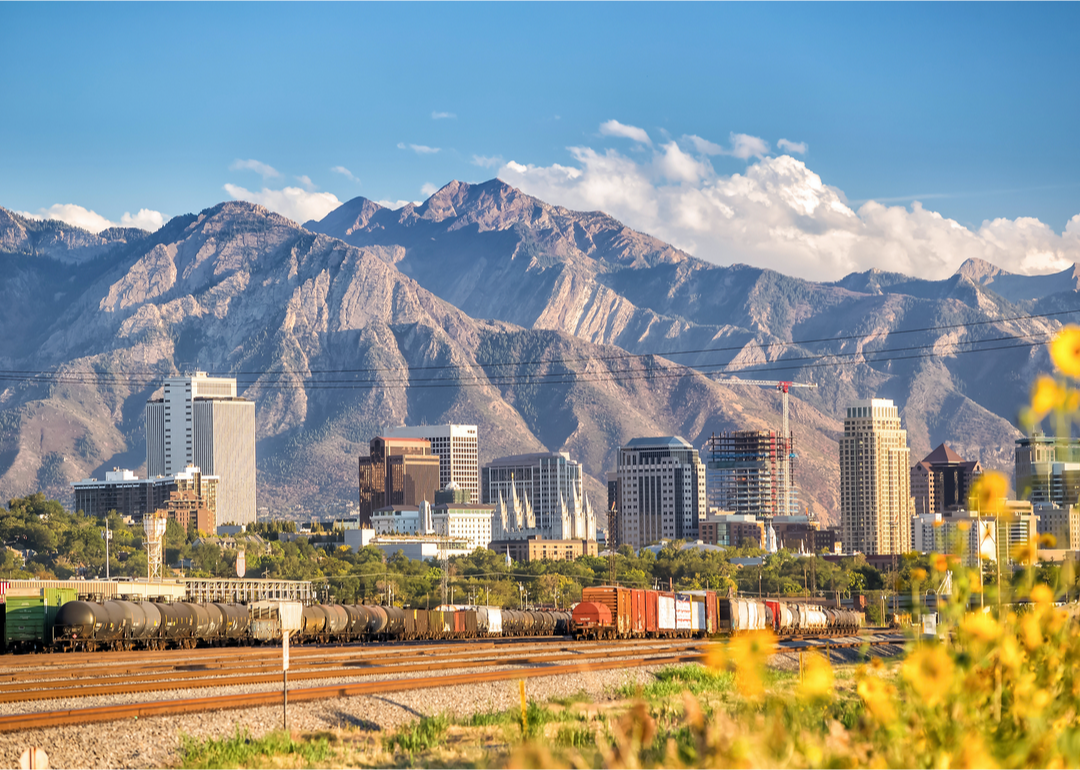
f11photo // Shutterstock
#25. Utah
Salt Lake City skyline.
Highest level of education completed:
– Less than 9th grade: 2.5%
– 9th to 12th grade, no diploma: 4.4%
– High school graduate (includes equivalency): 22.7%
– Some college, no degree: 25.1%
– Associate’s degree: 9.9%
– Bachelor’s degree: 23.5%
– Graduate or professional degree: 12.0%
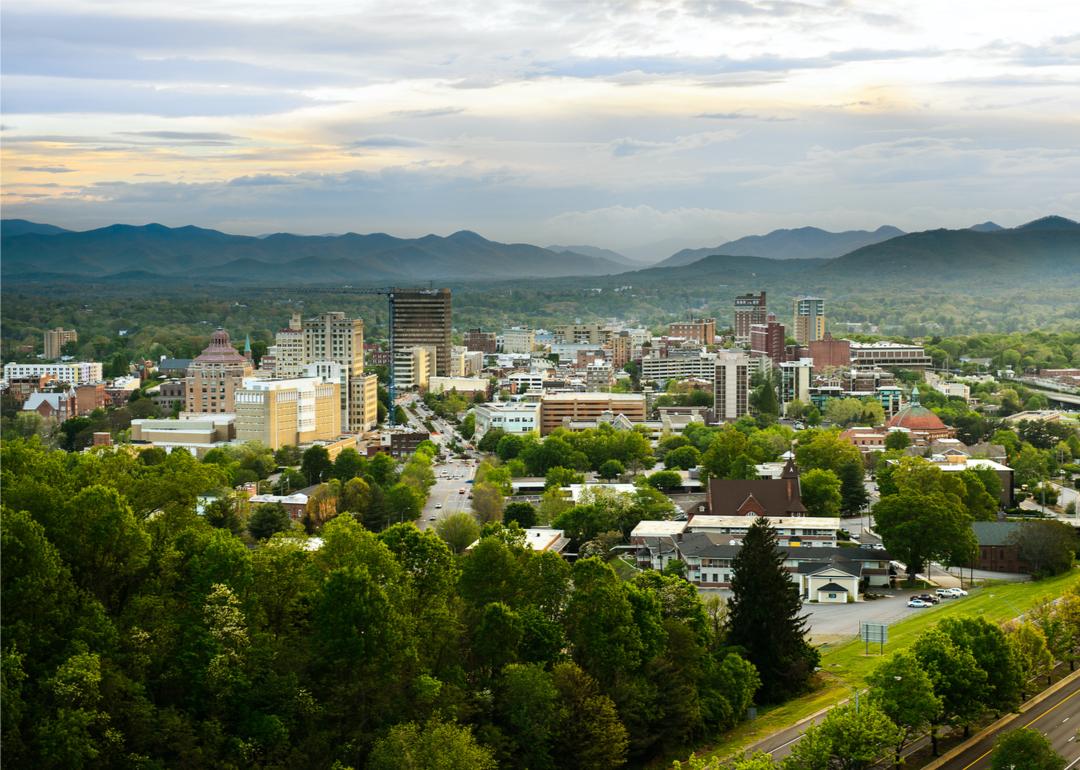
Derek Olson Photography // Shutterstock
#24. North Carolina
Asheville skyline in the fall.
Highest level of education completed:
– Less than 9th grade: 4.1%
– 9th to 12th grade, no diploma: 6.8%
– High school graduate (includes equivalency): 25.2%
– Some college, no degree: 20.8%
– Associate’s degree: 10.0%
– Bachelor’s degree: 20.9%
– Graduate or professional degree: 12.1%

Leigh Trail // Shutterstock
#23. Hawaii
Elevated view of downtown Honolulu.
Highest level of education completed:
– Less than 9th grade: 3.4%
– 9th to 12th grade, no diploma: 3.9%
– High school graduate (includes equivalency): 26.8%
– Some college, no degree: 20.5%
– Associate’s degree: 11.0%
– Bachelor’s degree: 22.2%
– Graduate or professional degree: 12.2%

Joseph Sohm // Shutterstock
#22. Maine
Aerial Portland harbor and cityscape.
Highest level of education completed:
– Less than 9th grade: 2.1%
– 9th to 12th grade, no diploma: 4.2%
– High school graduate (includes equivalency): 30.9%
– Some college, no degree: 18.9%
– Associate’s degree: 10.3%
– Bachelor’s degree: 21.0%
– Graduate or professional degree: 12.6%
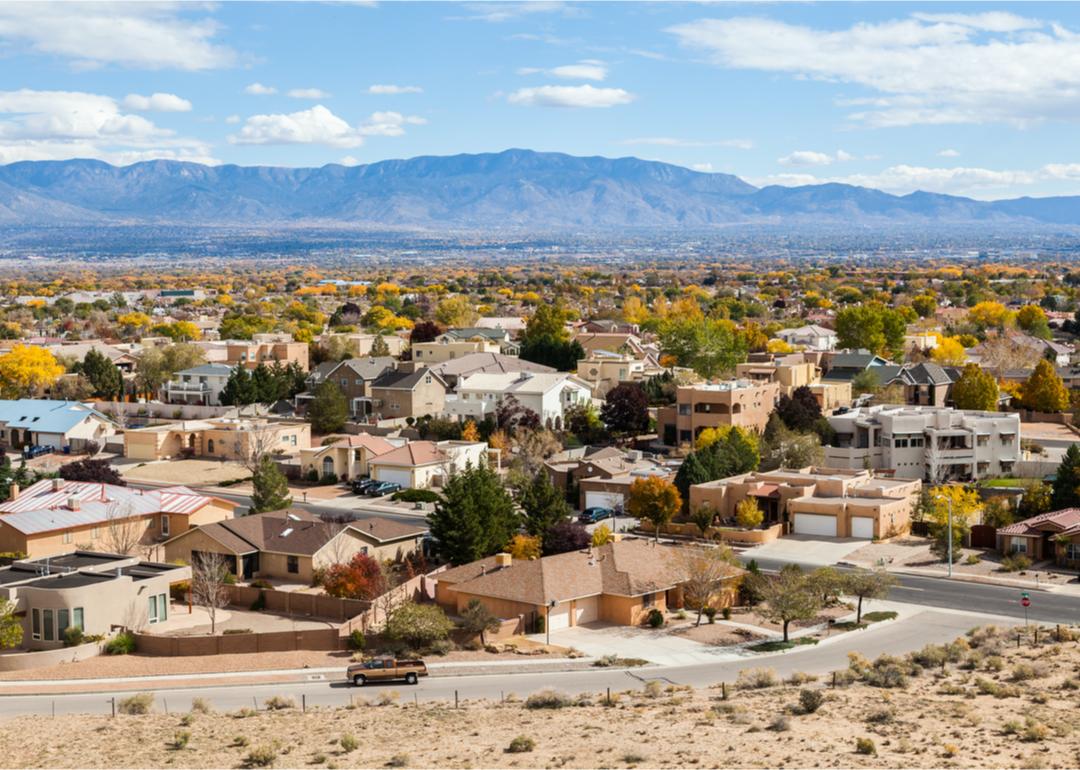
turtix // Shutterstock
#21. New Mexico
Albuquerque residential suburbs.
Highest level of education completed:
– Less than 9th grade: 5.4%
– 9th to 12th grade, no diploma: 7.8%
– High school graduate (includes equivalency): 26.0%
– Some college, no degree: 23.3%
– Associate’s degree: 8.9%
– Bachelor’s degree: 15.8%
– Graduate or professional degree: 12.7%

Sean Pavone // Shutterstock
#20. Georgia
Riverfront skyline in Savannah.
Highest level of education completed:
– Less than 9th grade: 4.4%
– 9th to 12th grade, no diploma: 7.4%
– High school graduate (includes equivalency): 27.2%
– Some college, no degree: 19.9%
– Associate’s degree: 8.2%
– Bachelor’s degree: 20.2%
– Graduate or professional degree: 12.8%

Sean Pavone // Shutterstock
#19. Kansas
River and Keeper of the Plains statue near downtown Wichita.
Highest level of education completed:
– Less than 9th grade: 3.5%
– 9th to 12th grade, no diploma: 4.9%
– High school graduate (includes equivalency): 25.7%
– Some college, no degree: 22.7%
– Associate’s degree: 8.9%
– Bachelor’s degree: 21.6%
– Graduate or professional degree: 12.8%

Canva
#18. Minnesota
Duluth skyline from lake.
Highest level of education completed:
– Less than 9th grade: 2.7%
– 9th to 12th grade, no diploma: 3.7%
– High school graduate (includes equivalency): 23.9%
– Some college, no degree: 20.5%
– Associate’s degree: 11.6%
– Bachelor’s degree: 24.6%
– Graduate or professional degree: 13.0%
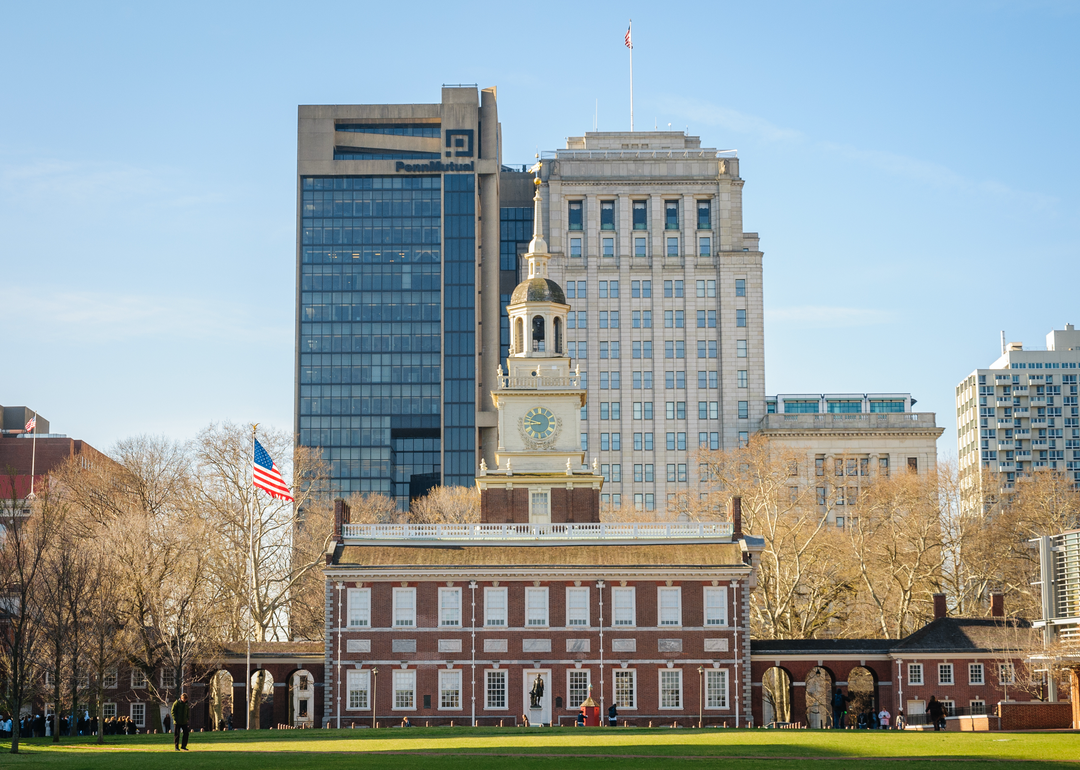
Zack Frank // Shutterstock
#17. Pennsylvania
Independence Hall in Philadelphia.
Highest level of education completed:
– Less than 9th grade: 3.0%
– 9th to 12th grade, no diploma: 5.6%
– High school graduate (includes equivalency): 33.8%
– Some college, no degree: 15.7%
– Associate’s degree: 8.7%
– Bachelor’s degree: 19.9%
– Graduate or professional degree: 13.2%

Josemaria Toscano // Shutterstock
#16. Oregon
Portland cityscape from Pittock Mansion.
Highest level of education completed:
– Less than 9th grade: 3.3%
– 9th to 12th grade, no diploma: 5.2%
– High school graduate (includes equivalency): 22.5%
– Some college, no degree: 24.9%
– Associate’s degree: 9.1%
– Bachelor’s degree: 21.7%
– Graduate or professional degree: 13.3%
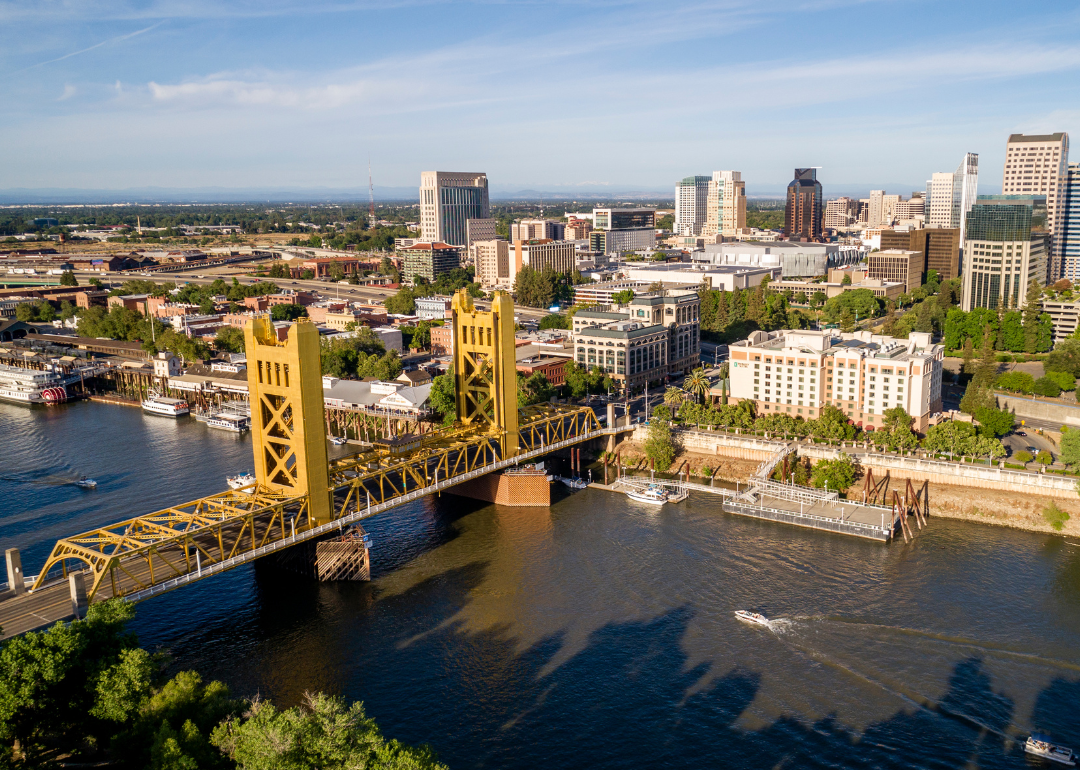
Canva
#15. California
Tower Bridge and Capitol Mall.
Highest level of education completed:
– Less than 9th grade: 8.7%
– 9th to 12th grade, no diploma: 7.1%
– High school graduate (includes equivalency): 20.4%
– Some college, no degree: 20.5%
– Associate’s degree: 8.0%
– Bachelor’s degree: 21.9%
– Graduate or professional degree: 13.4%
Real Window Creative // Shutterstock
#14. Delaware
Aerial view of Wilmington.
Highest level of education completed:
– Less than 9th grade: 3.2%
– 9th to 12th grade, no diploma: 5.7%
– High school graduate (includes equivalency): 30.4%
– Some college, no degree: 18.8%
– Associate’s degree: 8.2%
– Bachelor’s degree: 19.4%
– Graduate or professional degree: 14.2%
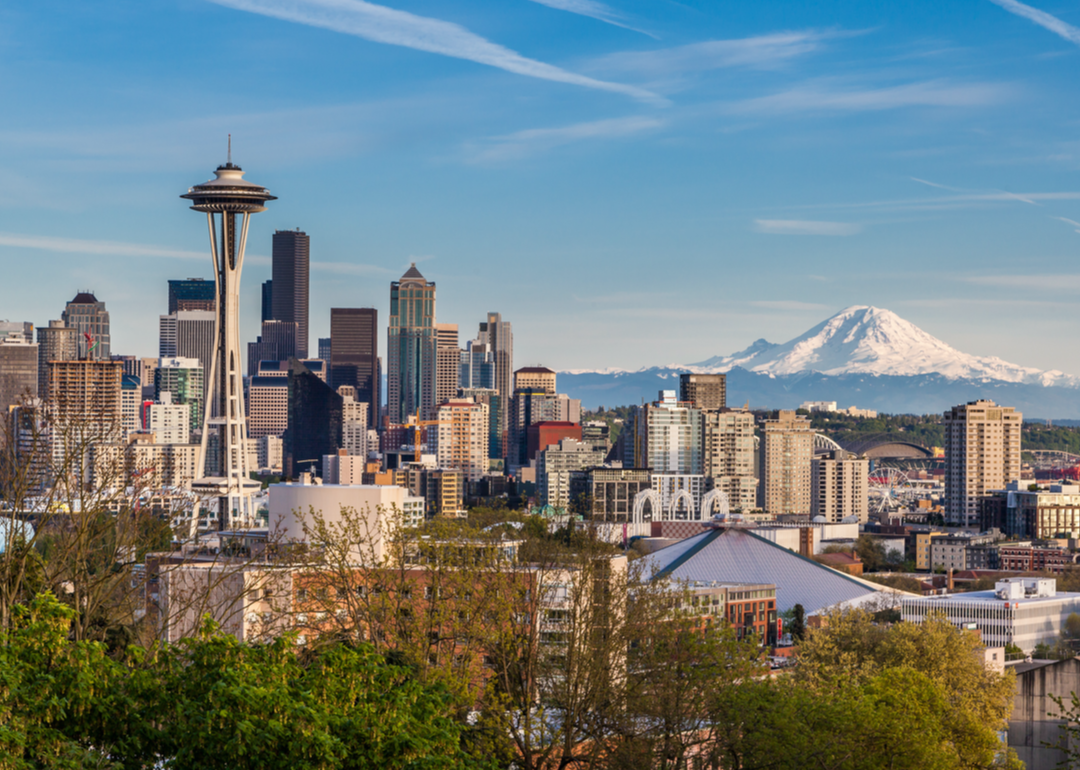
kan_khampanya// Shutterstock
#13. Washington
Elevated view of Seattle Space Needle and downtown.
Highest level of education completed:
– Less than 9th grade: 3.5%
– 9th to 12th grade, no diploma: 4.6%
– High school graduate (includes equivalency): 21.8%
– Some college, no degree: 22.7%
– Associate’s degree: 10.2%
– Bachelor’s degree: 23.1%
– Graduate or professional degree: 14.2%

Sean Pavone // Shutterstock
#12. Rhode Island
Providence cityscape.
Highest level of education completed:
– Less than 9th grade: 4.7%
– 9th to 12th grade, no diploma: 6.2%
– High school graduate (includes equivalency): 27.9%
– Some college, no degree: 17.7%
– Associate’s degree: 8.2%
– Bachelor’s degree: 20.9%
– Graduate or professional degree: 14.4%
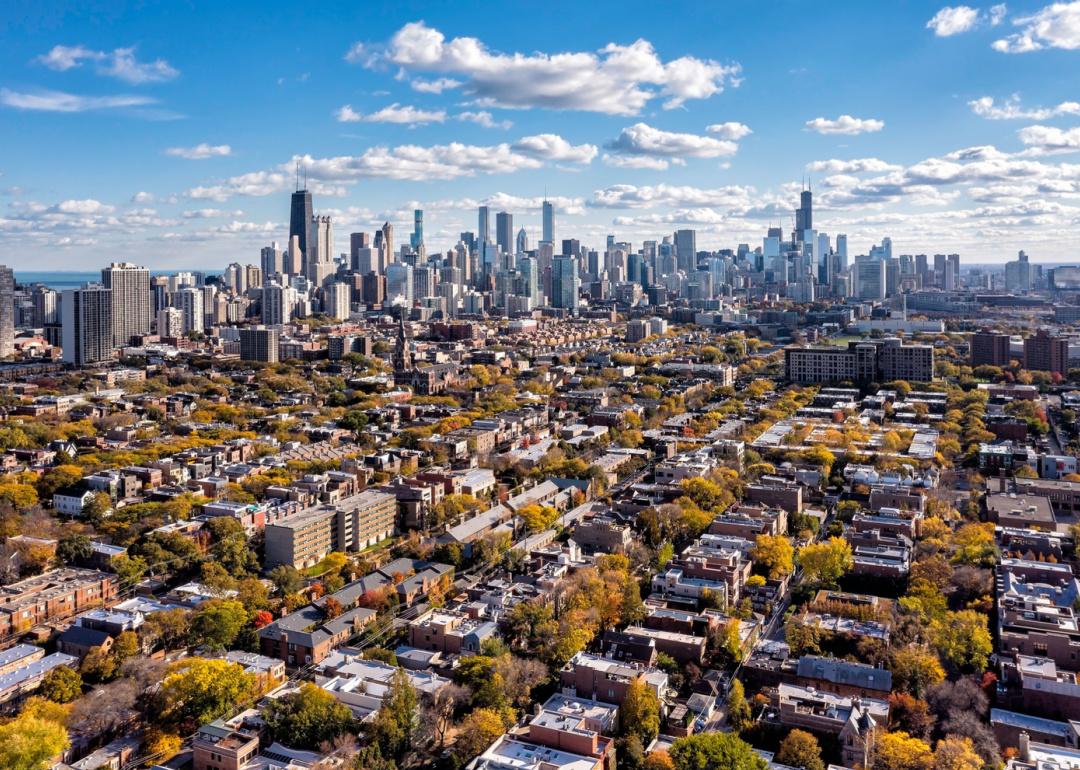
marchello74 // Shutterstock
#11. Illinois
Chicago neighborhood buildings and city skyline on sunny autumn day.
Highest level of education completed:
– Less than 9th grade: 4.6%
– 9th to 12th grade, no diploma: 5.6%
– High school graduate (includes equivalency): 25.4%
– Some college, no degree: 20.1%
– Associate’s degree: 8.2%
– Bachelor’s degree: 21.8%
– Graduate or professional degree: 14.4%
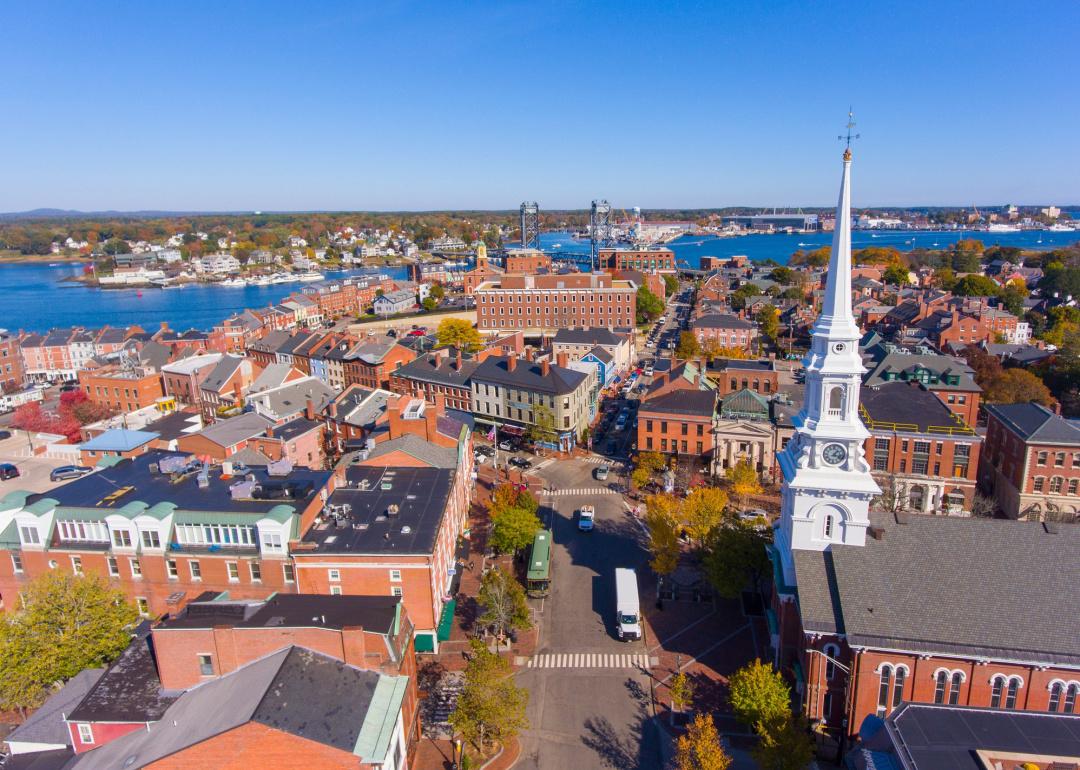
Wangkun Jia // Shutterstock
#10. New Hampshire
Aerial view of Market Square and North Church in Portsmouth.
Highest level of education completed:
– Less than 9th grade: 2.1%
– 9th to 12th grade, no diploma: 4.3%
– High school graduate (includes equivalency): 27.3%
– Some college, no degree: 17.8%
– Associate’s degree: 10.3%
– Bachelor’s degree: 23.4%
– Graduate or professional degree: 14.9%
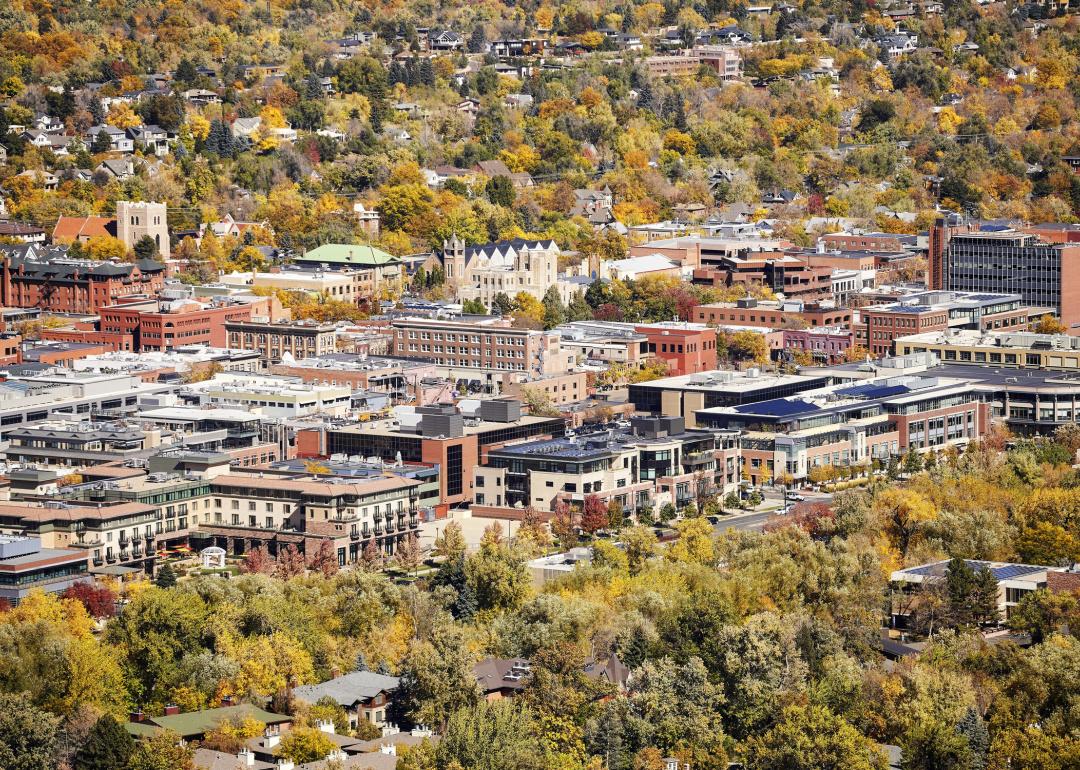
Maciej Bledowski // Shutterstock
#9. Colorado
Aerial view of Boulder City in autumn.
Highest level of education completed:
– Less than 9th grade: 3.2%
– 9th to 12th grade, no diploma: 4.4%
– High school graduate (includes equivalency): 20.6%
– Some college, no degree: 20.5%
– Associate’s degree: 8.5%
– Bachelor’s degree: 26.7%
– Graduate or professional degree: 16.1%
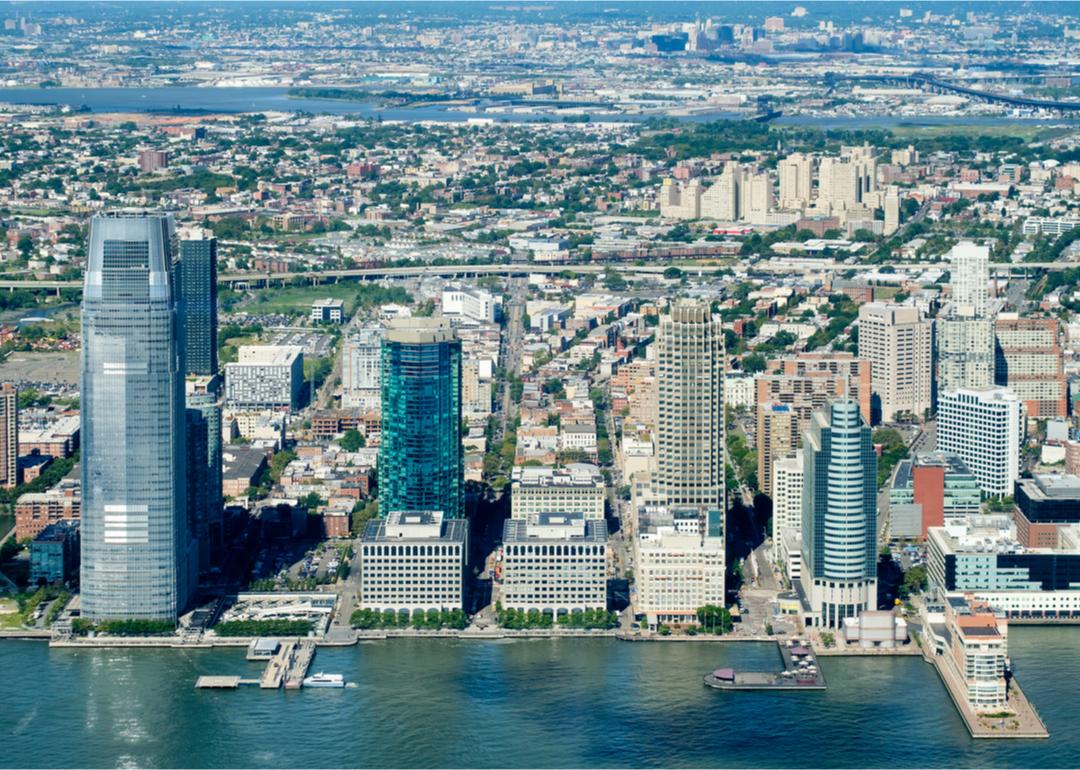
Kamira // Shutterstock
#8. New Jersey
Aerial view Jersey City.
Highest level of education completed:
– Less than 9th grade: 4.6%
– 9th to 12th grade, no diploma: 4.9%
– High school graduate (includes equivalency): 26.4%
– Some college, no degree: 15.9%
– Associate’s degree: 6.7%
– Bachelor’s degree: 25.1%
– Graduate or professional degree: 16.4%
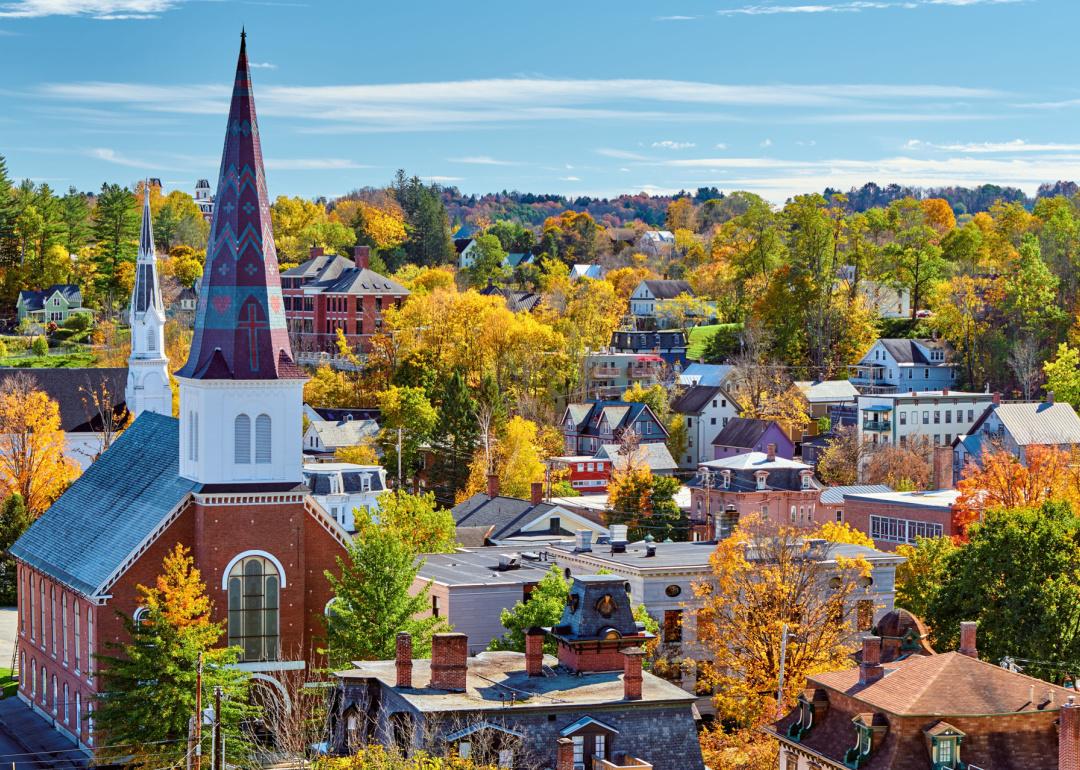
haveseen // Shutterstock
#7. Vermont
Montpelier city skyline.
Highest level of education completed:
– Less than 9th grade: 1.8%
– 9th to 12th grade, no diploma: 4.3%
– High school graduate (includes equivalency): 28.0%
– Some college, no degree: 16.5%
– Associate’s degree: 8.6%
– Bachelor’s degree: 24.2%
– Graduate or professional degree: 16.7%

Canva
#6. New York
New York City Skyline.
Highest level of education completed:
– Less than 9th grade: 6.0%
– 9th to 12th grade, no diploma: 6.6%
– High school graduate (includes equivalency): 25.2%
– Some college, no degree: 15.2%
– Associate’s degree: 8.9%
– Bachelor’s degree: 21.3%
– Graduate or professional degree: 16.8%
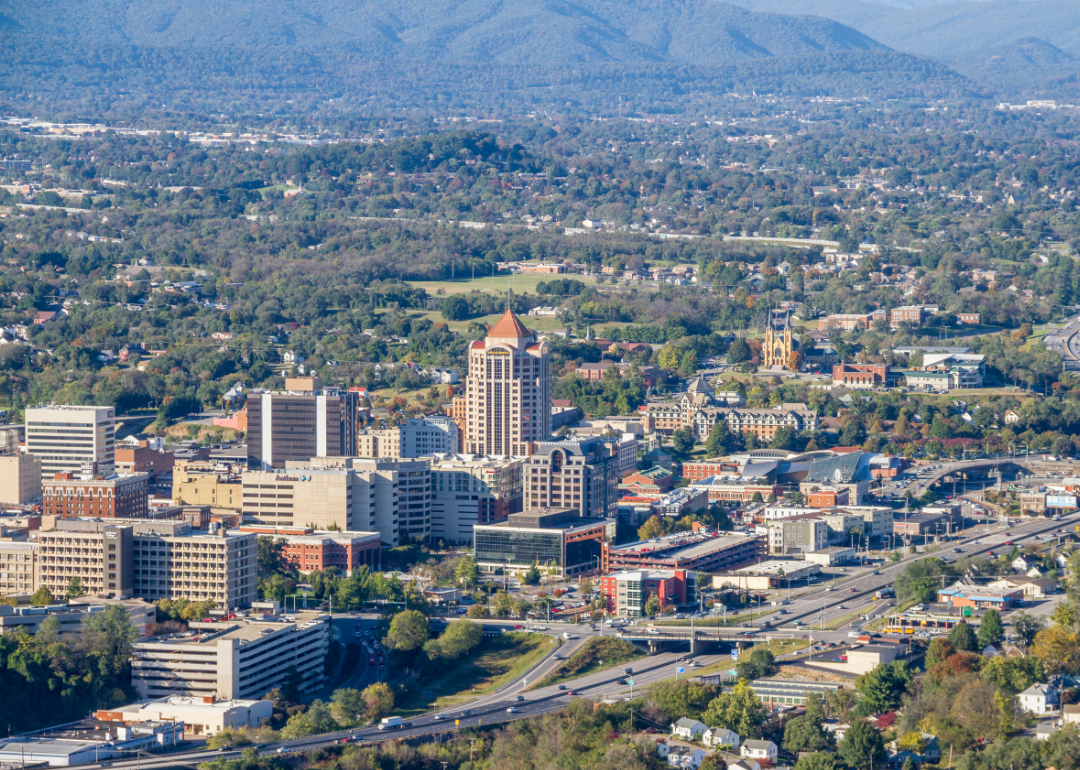
Canva
#5. Virginia
Aerial view of Roanoke.
Highest level of education completed:
– Less than 9th grade: 3.7%
– 9th to 12th grade, no diploma: 5.5%
– High school graduate (includes equivalency): 23.8%
– Some college, no degree: 18.7%
– Associate’s degree: 7.9%
– Bachelor’s degree: 22.8%
– Graduate or professional degree: 17.6%

Laura Stone // Shutterstock
#4. Connecticut
Hartford Skyline in autumn.
Highest level of education completed:
– Less than 9th grade: 4.0%
– 9th to 12th grade, no diploma: 4.9%
– High school graduate (includes equivalency): 26.1%
– Some college, no degree: 16.6%
– Associate’s degree: 7.8%
– Bachelor’s degree: 22.3%
– Graduate or professional degree: 18.2%
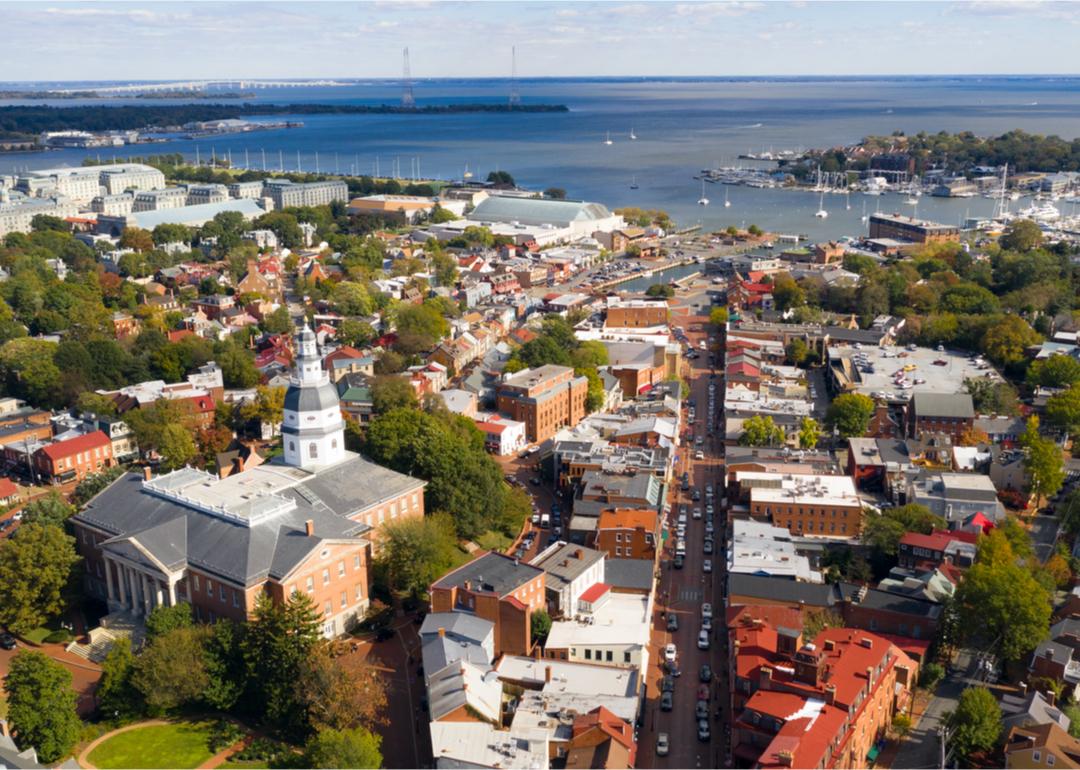
Real Window Creative // Shutterstock
#3. Maryland
Aerial view of Annapolis and Statehouse.
Highest level of education completed:
– Less than 9th grade: 3.8%
– 9th to 12th grade, no diploma: 5.4%
– High school graduate (includes equivalency): 23.9%
– Some college, no degree: 18.4%
– Associate’s degree: 6.9%
– Bachelor’s degree: 22.0%
– Graduate or professional degree: 19.5%

lunamarina // Shutterstock
#2. Massachusetts
Boston skyline with river.
Highest level of education completed:
– Less than 9th grade: 4.2%
– 9th to 12th grade, no diploma: 4.6%
– High school graduate (includes equivalency): 23.2%
– Some college, no degree: 15.1%
– Associate’s degree: 7.7%
– Bachelor’s degree: 24.8%
– Graduate or professional degree: 20.4%
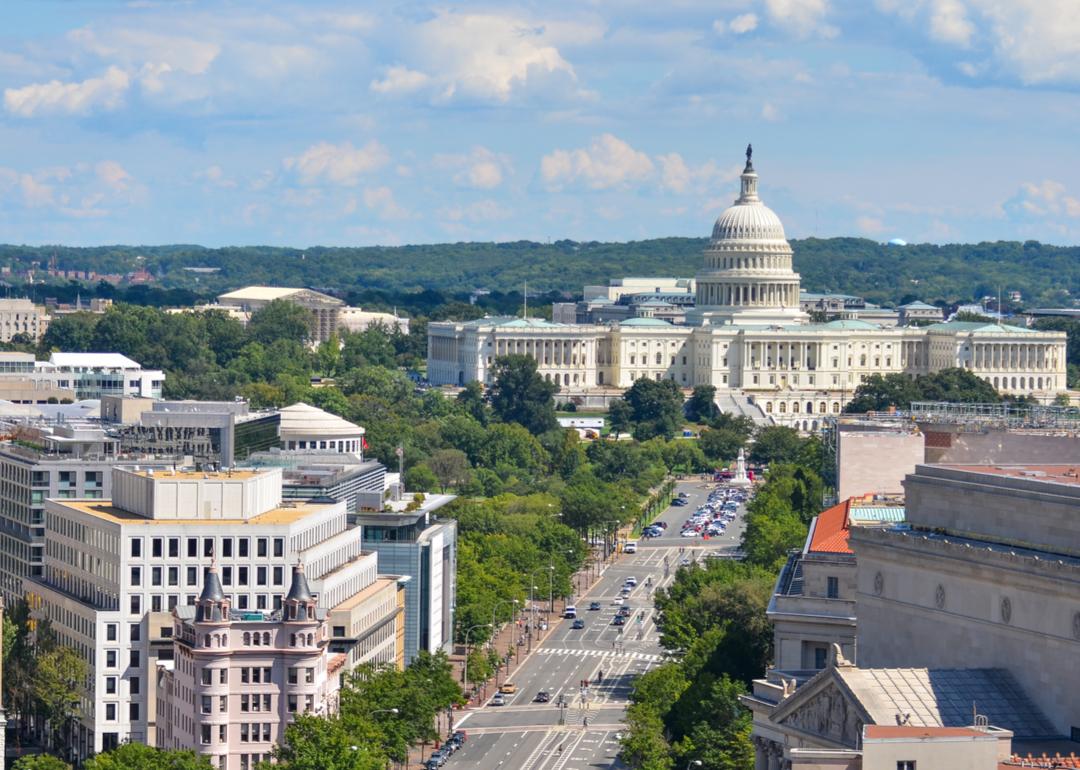
Orhan Cam // Shutterstock
#1. Washington D.C.
Pennsylvania Avenue and US Capitol.
Highest level of education completed:
– Less than 9th grade: 3.2%
– 9th to 12th grade, no diploma: 4.5%
– High school graduate (includes equivalency): 15.5%
– Some college, no degree: 12.4%
– Associate’s degree: 3.0%
– Bachelor’s degree: 25.5%
– Graduate or professional degree: 35.9%
